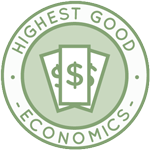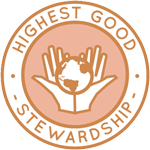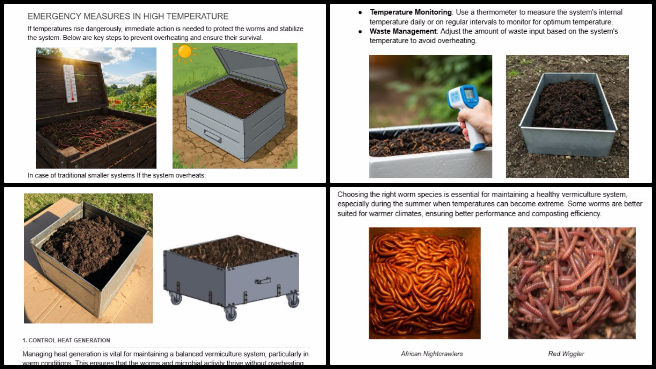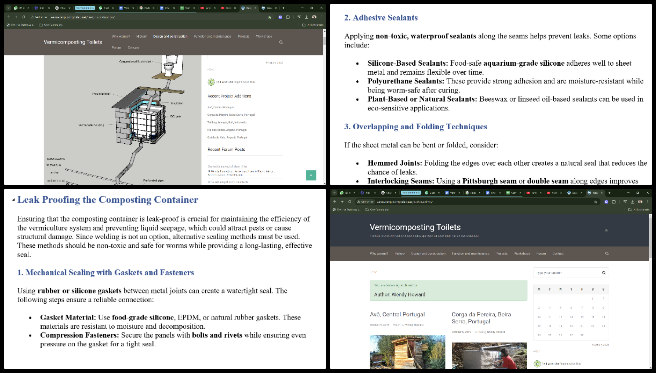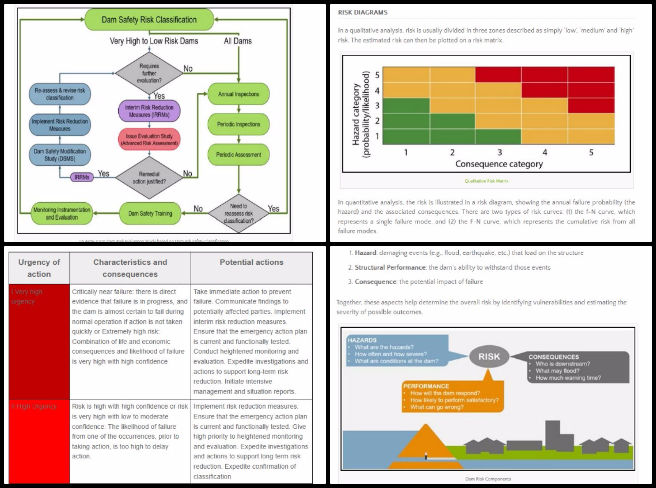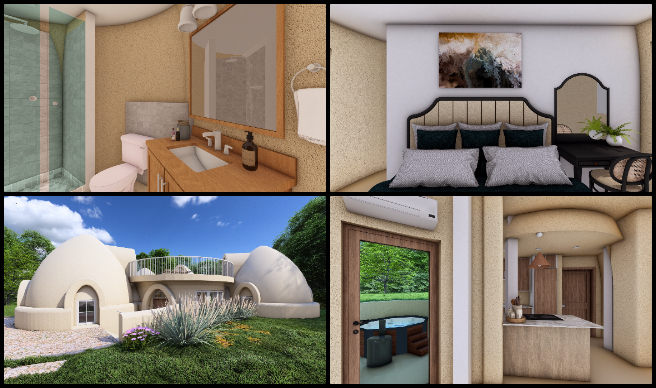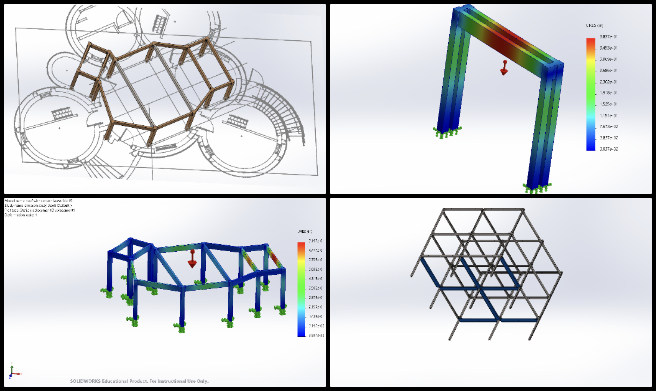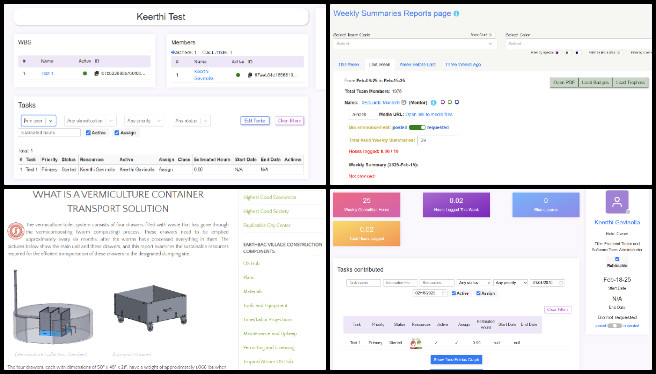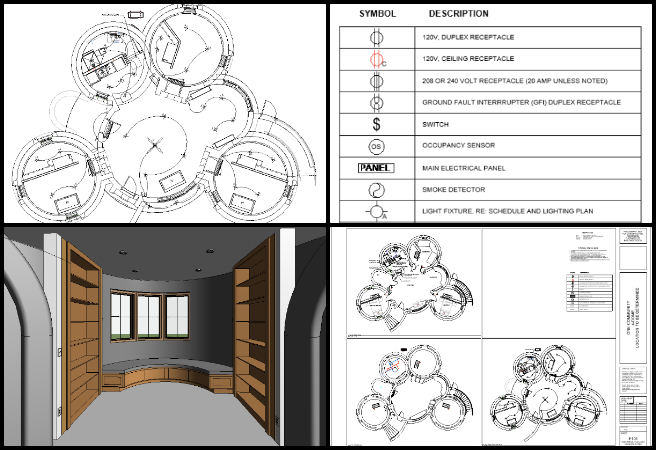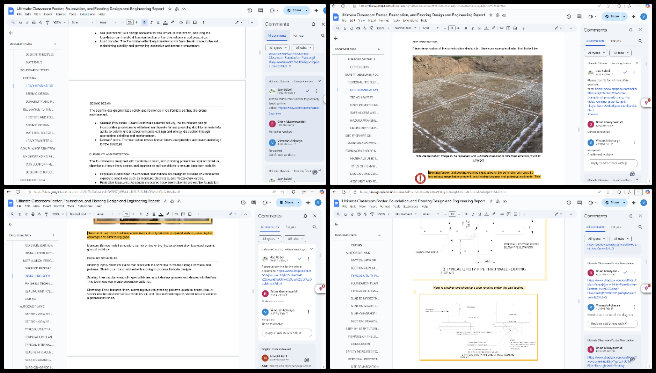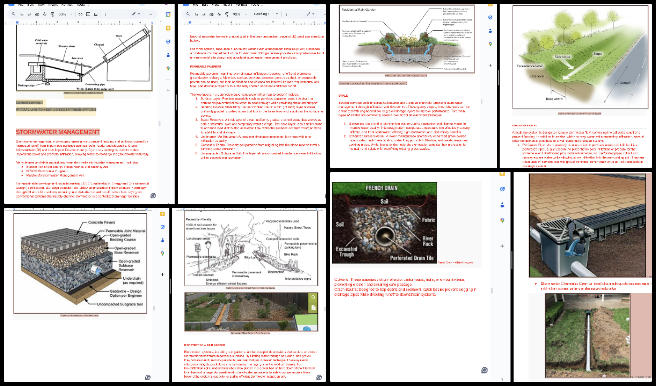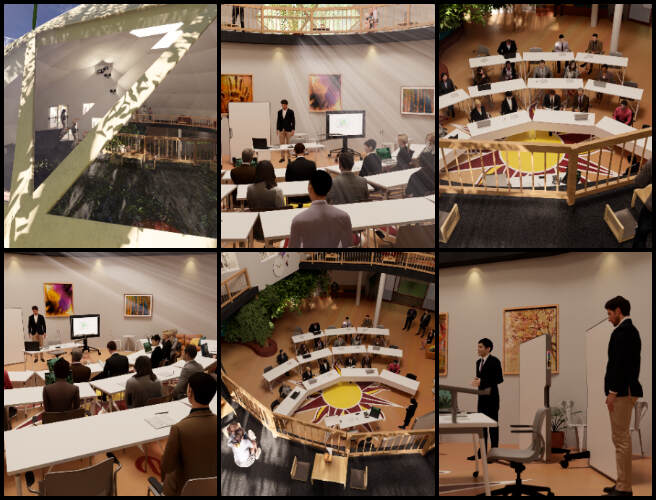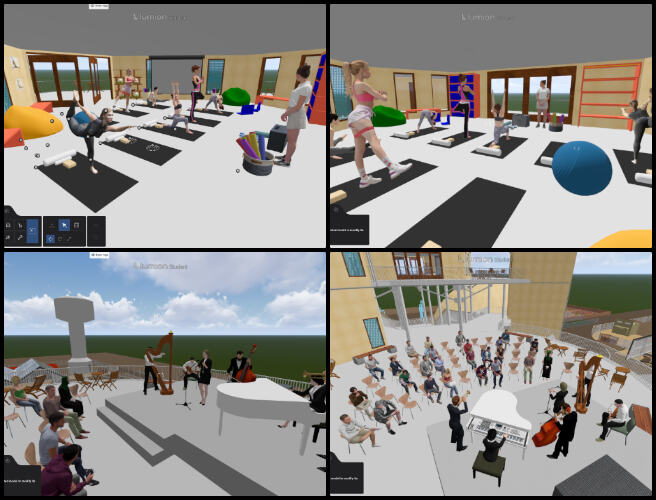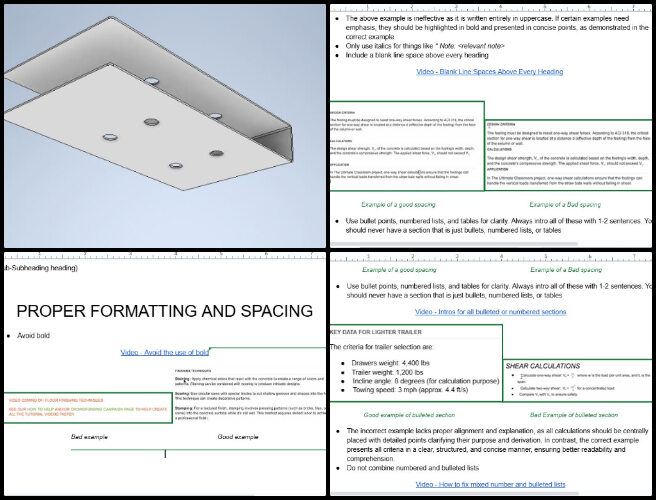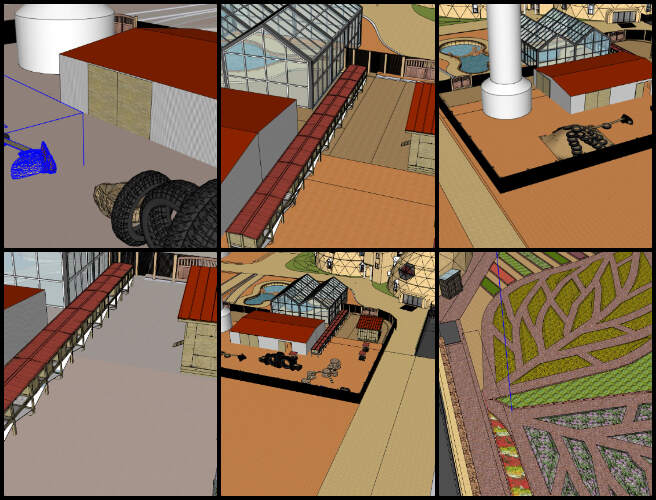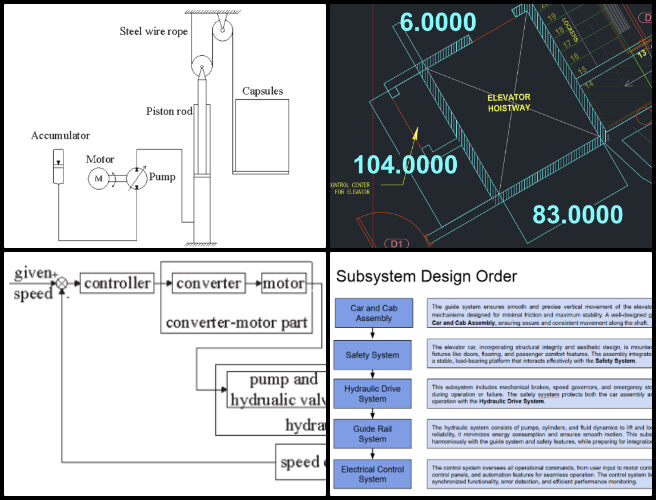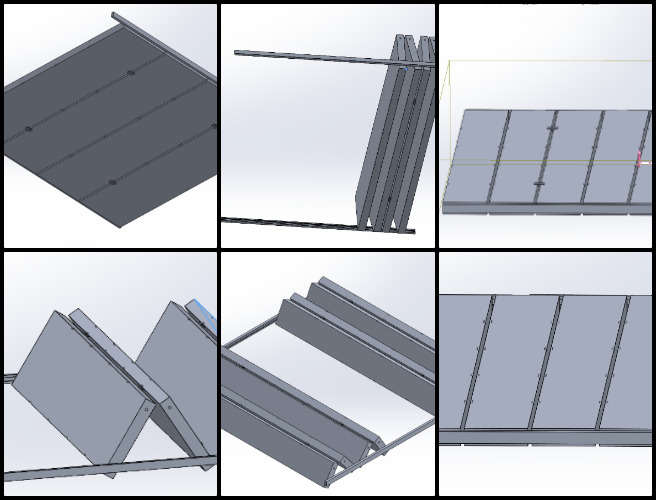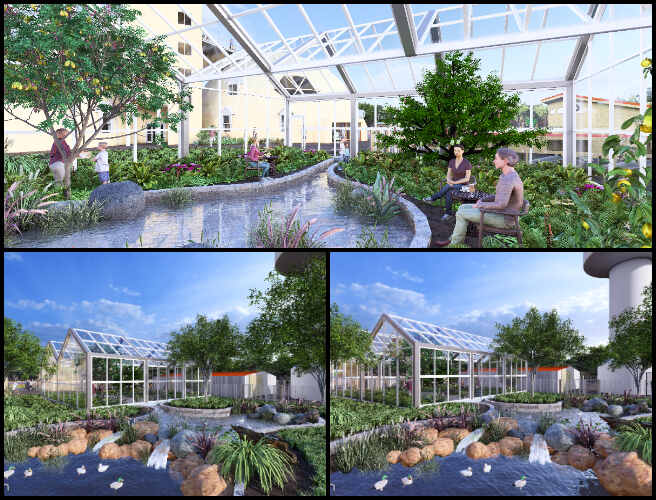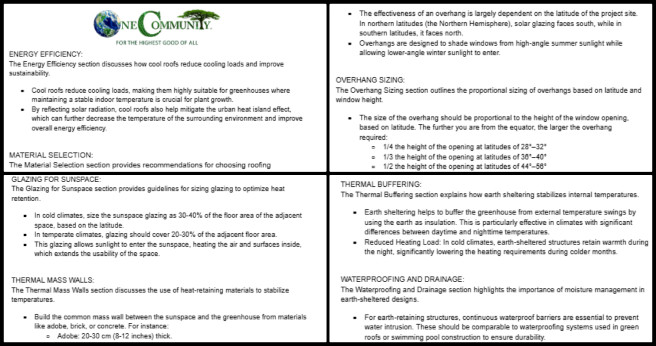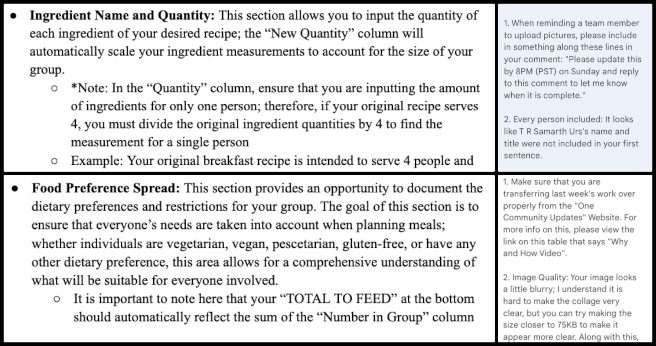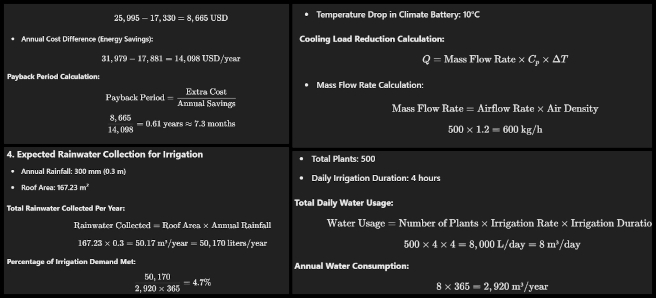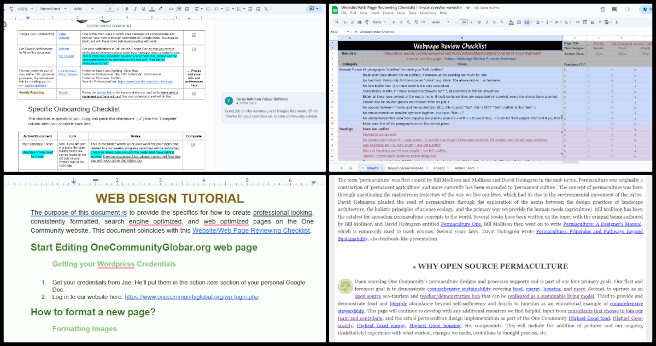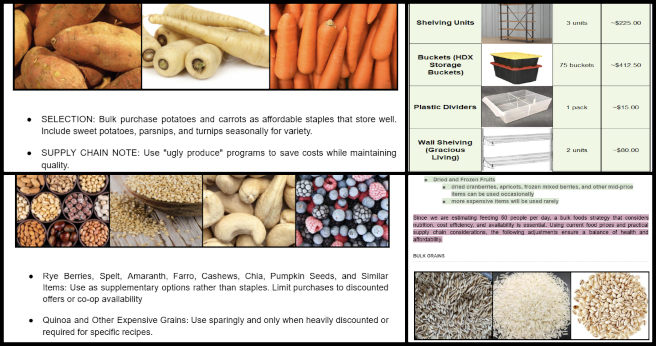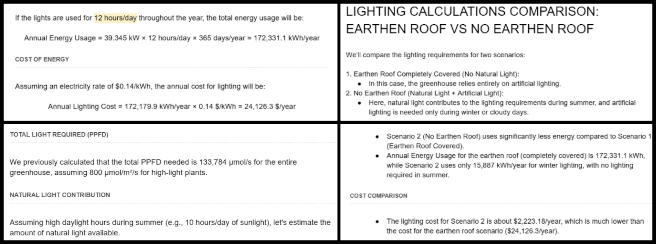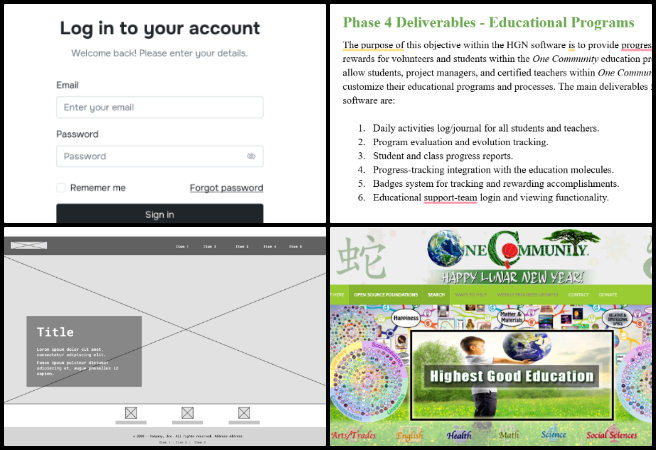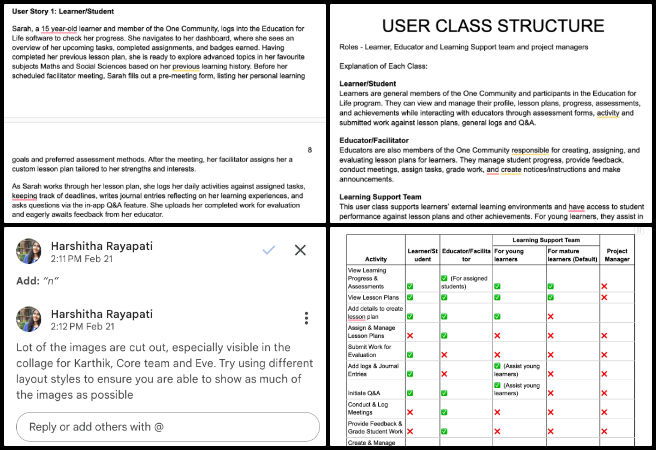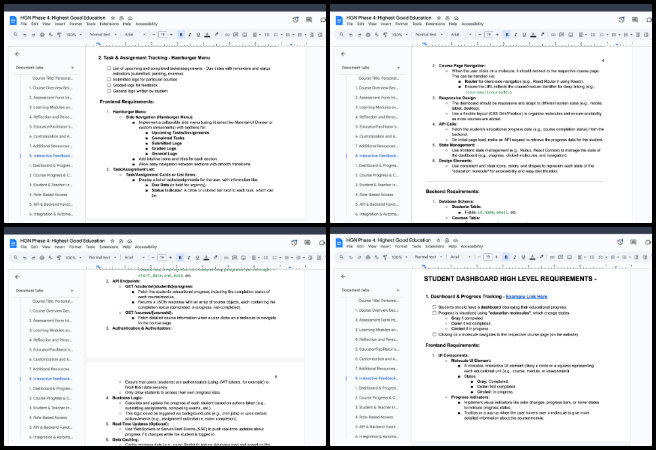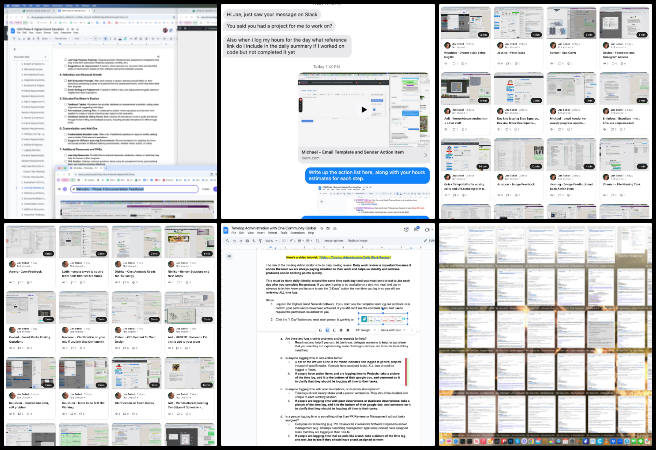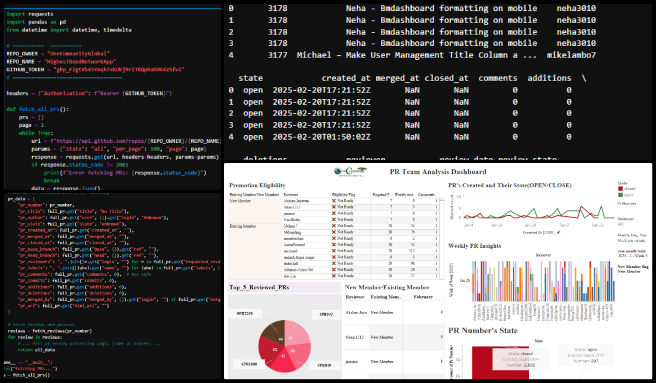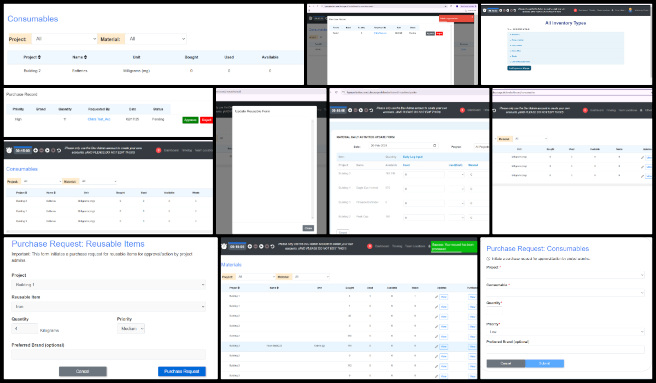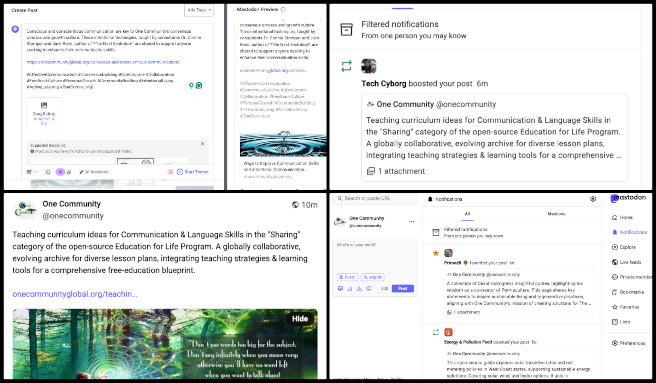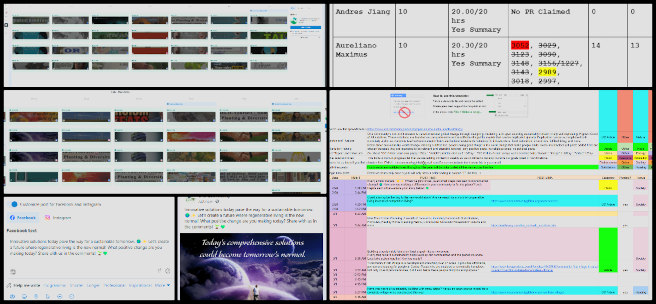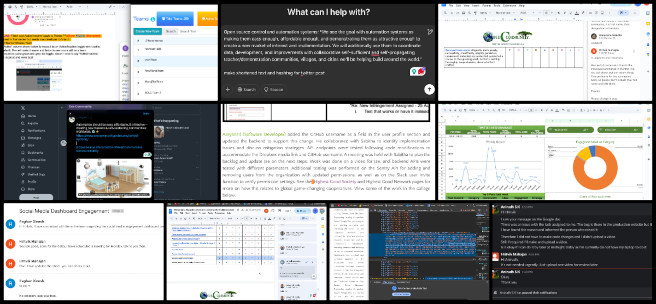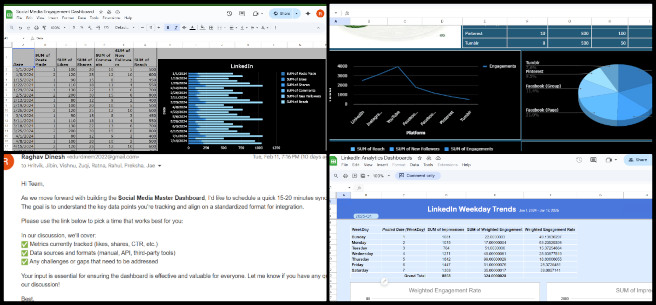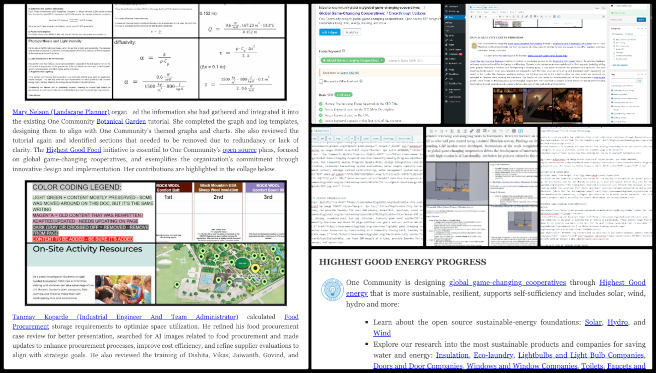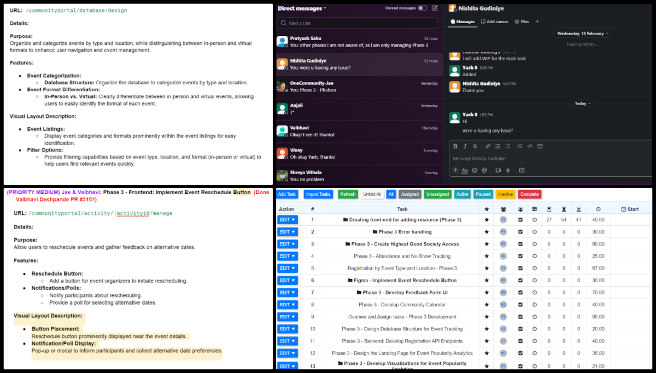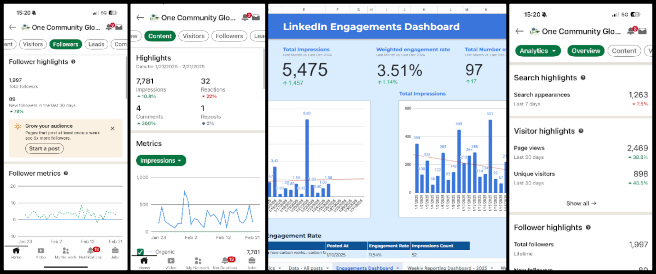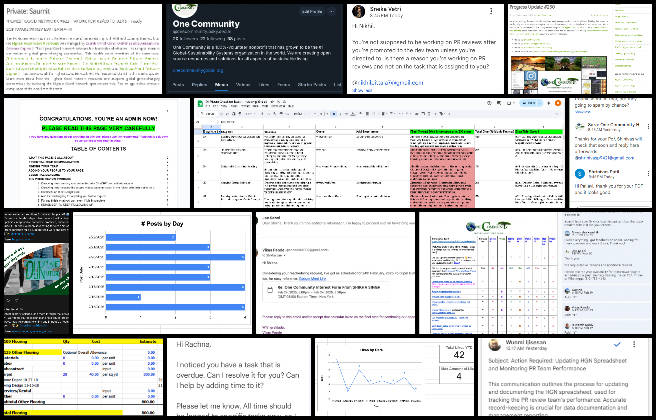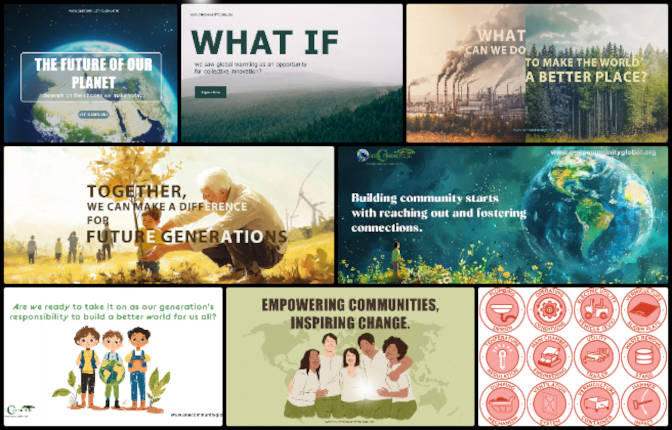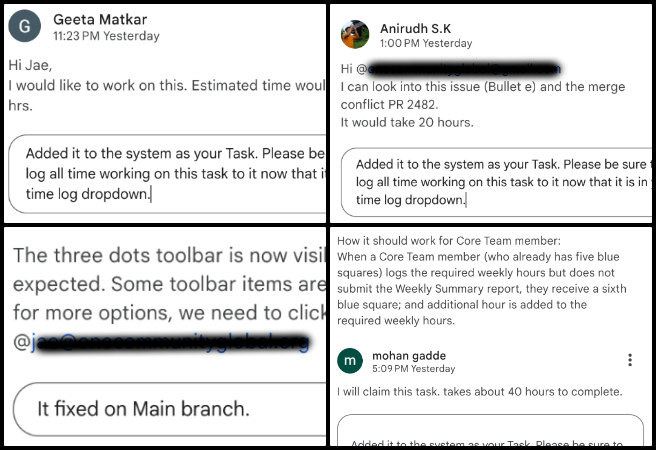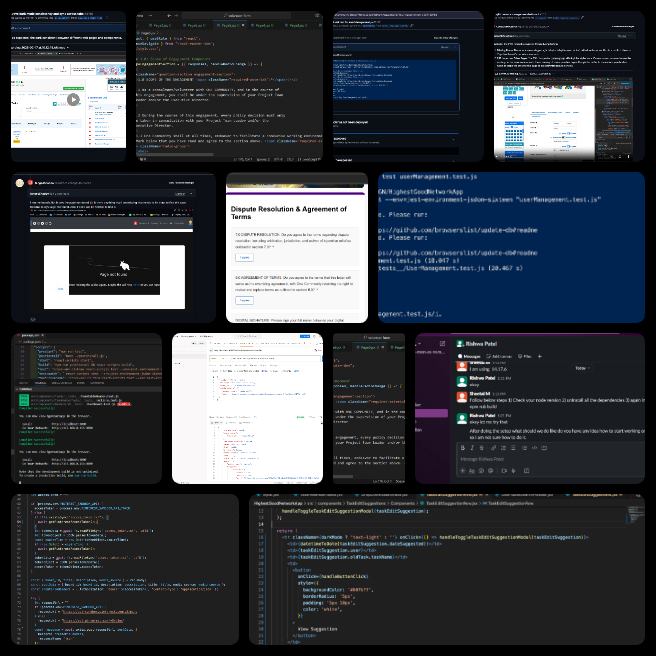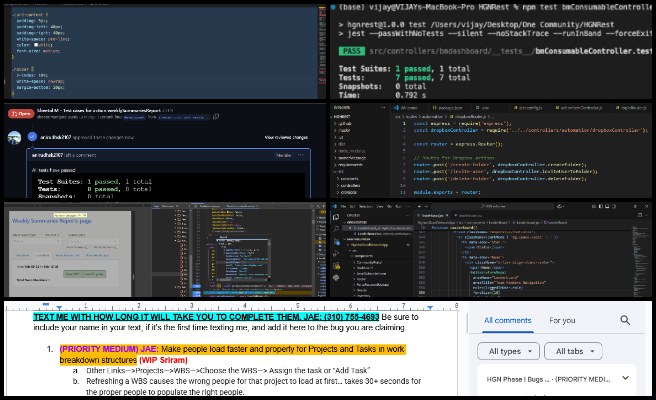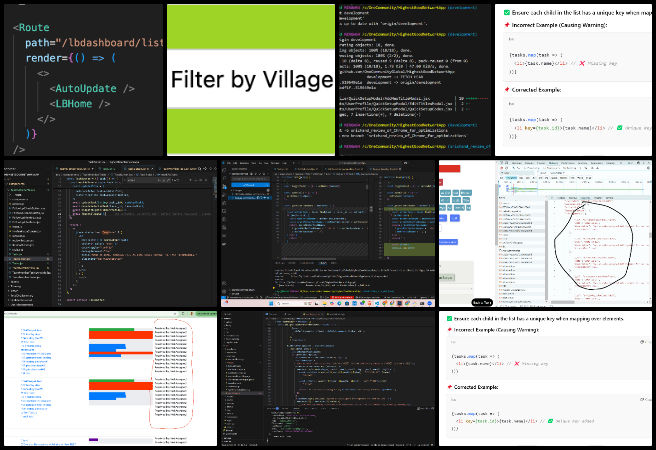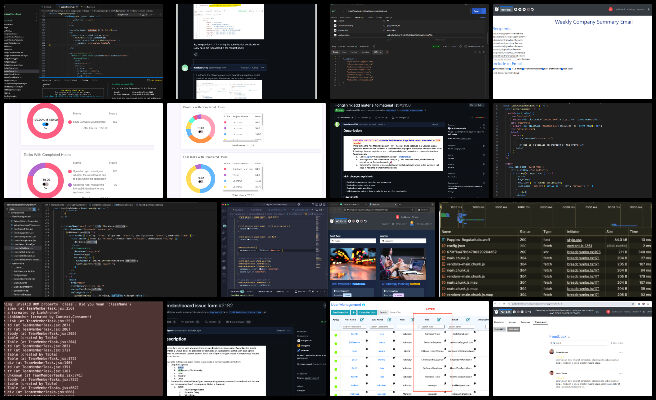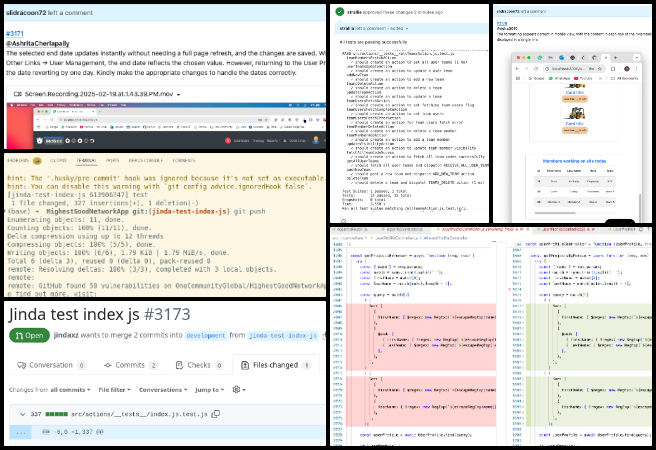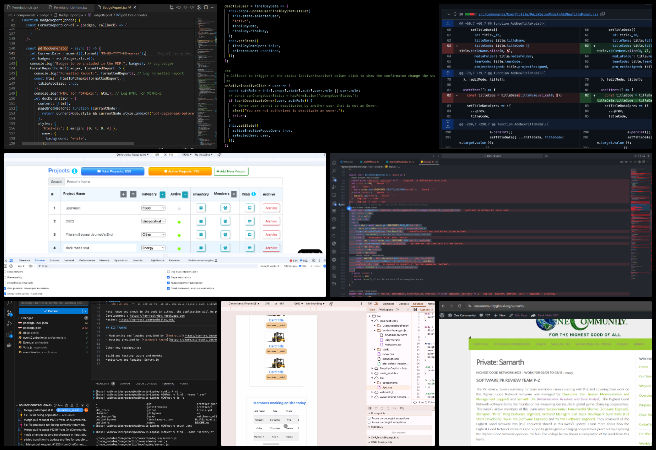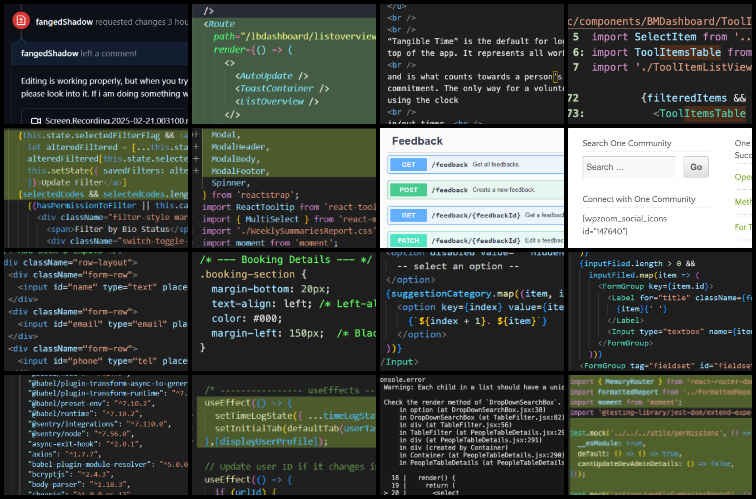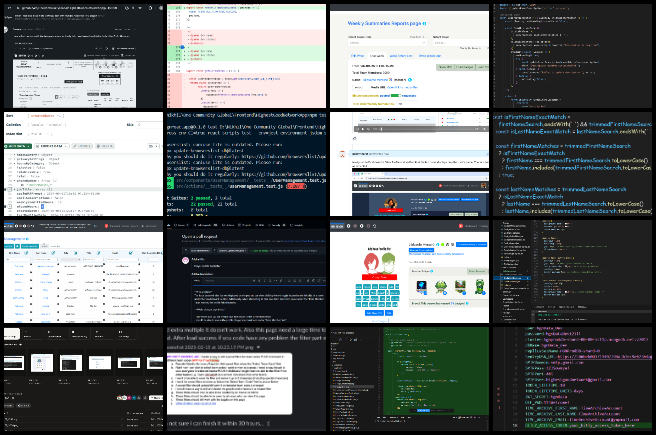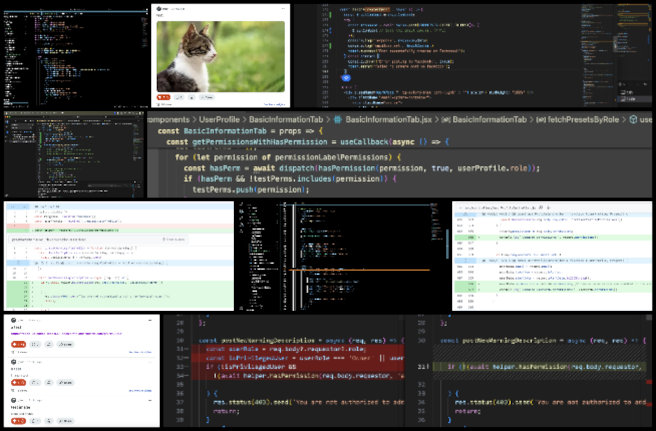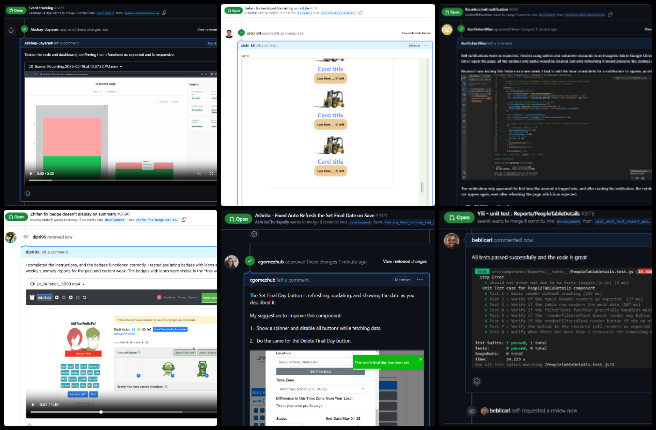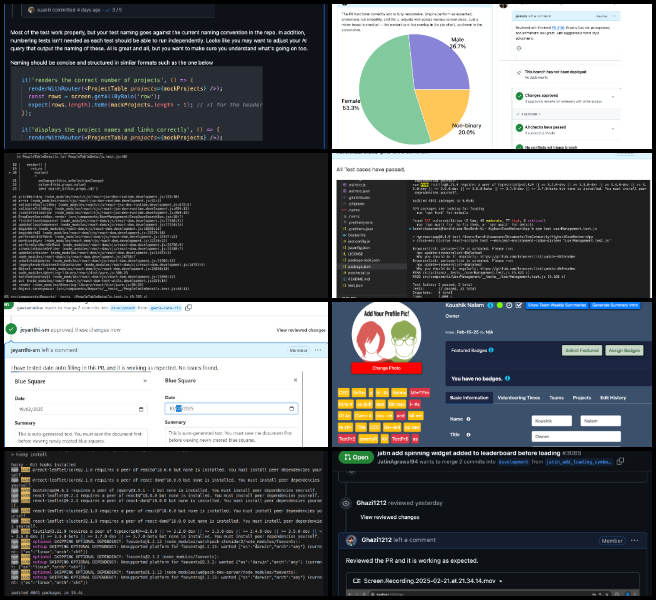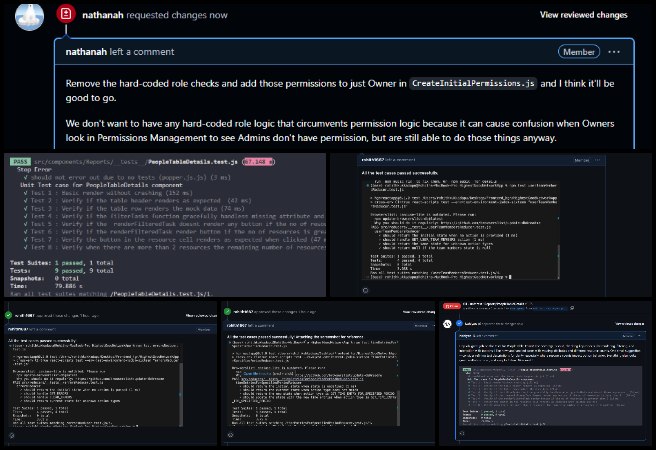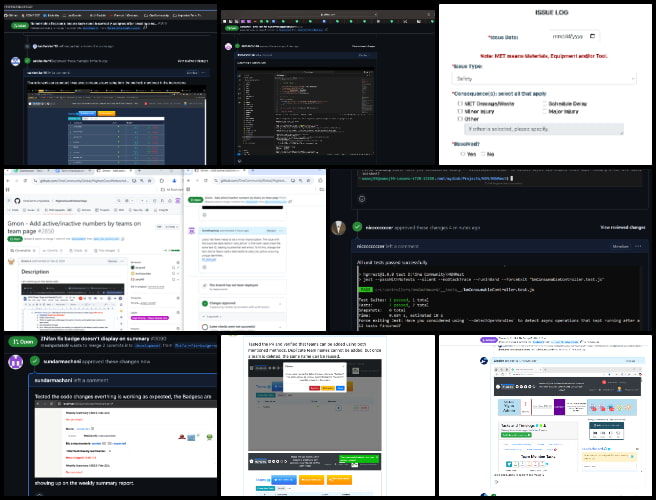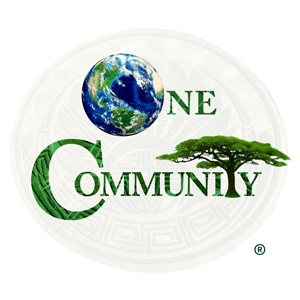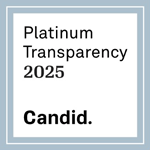Launching a Collaborative of New Sustainable Living Models – One Community Weekly Progress Update #623
One Community is dedicated to launching a collaborative of new sustainable living models as we pioneer sustainable approaches to food, energy, housing, education, for-profit and non-profit economic design, social architecture, fulfilled living. Our innovative model is designed to become self-replicating, inspiring a global network of teacher/demonstration hubs. Embracing the principle of “The Highest Good of All,” we are committed to open sourcing and free sharing the complete process.
- Here’s our project overview
- Here’s our world-change methodology
- Here’s how this becomes self-replicating
- Here’s how we are open source and free-sharing all the do-it-yourself designs
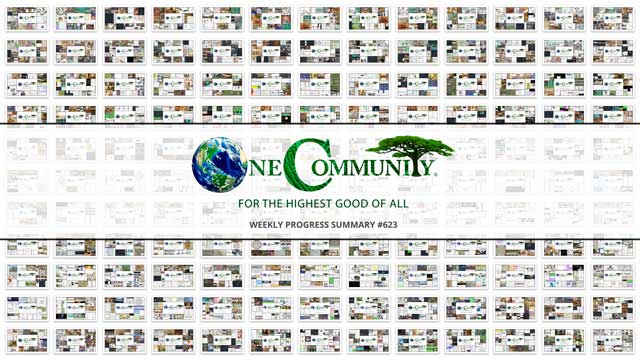
OUR MAIN OPEN SOURCE HUBS
Click on each icon to be taken to the corresponding Highest Good hub page.
One Community’s physical location will forward this movement as the first of many self-replicating teacher/demonstration communities, villages, and cities to be built around the world. This is the February 24th, 2025 edition (#623) of our weekly progress update detailing our team’s development and accomplishments:
Launching a Collaborative of
New Sustainable Living Models
One Community Progress Update #623
DONATE | COLLABORATE | HELP WITH LARGE-SCALE FUNDING
CLICK HERE IF YOU’D LIKE TO RECEIVE AN EMAIL EACH WEEK WHEN WE RELEASE A NEW UPDATE
YOU CAN ALSO JOIN US THROUGH SOCIAL MEDIA
ONE COMMUNITY WEEKLY UPDATE DETAILS
HIGHEST GOOD HOUSING PROGRESS
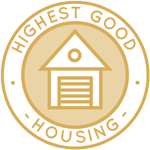 One Community is launching a collaborative of new sustainable living models through Highest Good housing that is artistic and beautiful, more affordable, more space efficient, lasts longer, DIY buildable, and constructed with healthy and sustainable materials:
One Community is launching a collaborative of new sustainable living models through Highest Good housing that is artistic and beautiful, more affordable, more space efficient, lasts longer, DIY buildable, and constructed with healthy and sustainable materials:
- Learn about: Our Upcoming Crowdfunding Campaign
- Learn about the different village models: 7 Sustainable Village Models
- Visit the open source portals for the first two: Earthbag Village OS Hub | Straw Bale Village OS Hub
This week, Adil Zulfiquar (Engineer) continued working on the Vermiculture Toilet engineering designs. Changes were made to the operating conditions report based on review feedback, modifying methods and scenarios to align with the vermiculture system and adding images to illustrate processes. The webpage content for the vermiculture structure was updated by reorganizing information to reflect the latest design, and older CAD files were moved to archives. The Earthbag Village, the first of seven planned villages, serves as the initial housing component within One Community’s open source model for launching a collaborative of new sustainable living models. See below for some of the pictures related to this work.
Anil Karathra (Mechanical Engineer) continued advancing the engineering and design of the Vermiculture Toilet for the Earthbag Village project. Feedback from Jae was reviewed, and a reply video was created while researching vermiculture toilets that incorporate conventional designs. The weekly team meeting included reviewing ongoing tasks and assigning new objectives. Research was done on leak-proofing containers and vermiculture structures, with findings documented and formatted. Schematics were created for drain water filtration, and CAD concepts for knockdown mechanism trapdoors were developed based on Jae’s feedback. A weekly summary was compiled, and screenshots of past work were uploaded to Dropbox. This commitment to launching a collaborative of new sustainable living models drives the development of innovative, eco-friendly solutions that balance environmental responsibility with high standards of functionality. See below for pictures related to this work.
Charles Gooley (Web Designer) continued working on the Open Source DIY Dam Design for Water Retention, Pond and Lake Creation, etc. page. Charles updated the Open Source DIY Earth Dam Design & Construction for Water Retention, Pond & Lake Creation by rewording, clarifying content, and making additions to the tables of contents. New material was added to the Dam Risk Analysis and Management section, covering dam risk analysis, assessment, risk tolerability, risk diagrams, and risk management. A table was created to outline urgency of action, characteristics and consequences, and potential actions. Dam Design is important for the Earthbag Village, a foundational part of One Community’s open-source model for launching a collaborative of new sustainable living models. Take a look at some of the work in the images below.
Faeq Abu Alia (Architectural Engineer) continued his work on the Earthbag Village 4-dome home renders. Faeq focused on refining the exterior entrance and interior rooms, addressing functionality, aesthetics, and overall coherence through material selection and visual adjustments. Changes were made to enhance the spatial flow and ensure design consistency across various areas. Work also progressed on creating a walkthrough video to present the design. The Earthbag Village is the first of 7 to be built as the housing component of One Community’s open source model for launching a collaborative of new sustainable living models. View examples of this work in the pictures provided below.
Karthik Pillai (Mechanical Engineer) continued helping finish the Vermiculture Toilet engineering and helping with the Earthbag Village 4-dome home roof plan. Karthik worked on the four-dome cluster roof project, analyzing the kitchen column and joist, which were identified as critical. Finite element analysis was completed, and the results were provided to Michaela. Preliminary outcomes based on the revised column layout and additional columns appeared favorable, but further discussion with the team is needed before proceeding under Michaela’s direction. In the vermiculture toilet design, a component was designed to hold the slider and address system gap issues. Initial iterations indicated potential improvements. Research was also conducted on an alternative material to replace steel Unistruts, following a suggestion from Manjiri. The Earthbag Village is the first of 7 to be built as the housing component of One Community’s open source model for launching a collaborative of new sustainable living models. See the work in the collage below.
Keerthi Reddy Gavinolla (Software Developer) started working on the Vermiculture Toilet engineering designs. Keerthi updated Blog 622, made the suggested changes, and submitted the final version. Keerthi also reviewed Himanshu and Mimansha’s onboarding checklist and examined the HGN Phase I Bugs and Needed Functionalities document to test merged PRs. As part of the testing, fixes and features for PR 3143, PR 3024, and others were verified on the dev site, and feedback was provided to Jae as requested. Lastly, work began on the web page design by adding content from the provided document to the blog page and editing images. The Earthbag Village, the first of seven planned villages, serves as the initial housing component within One Community’s open source model for launching a collaborative of new sustainable living models. See below for some of the pictures related to this work.
Michaela Silva (Architect) continued working on the interior details for the Earthbag Village 4-dome home design. Michaela completed the electrical design in the Revit model, developing a switching plan for the light fixtures, fan, disposal, and exhaust fan. Small walls were added against the dining room columns to house the switch and outlet. She also collaborated with the team to finalize the kitchen opening structure, which will consist of four 6×6 columns and two 4×12 beams. As the first of seven villages in One Community’s open source plan for launching a collaborative of new sustainable living models, the Earthbag Village represents the housing element. See her work in the collage below.
Vimarsh Acharya (Engineering Manager and Technical Reviewer) continued working on identifying sustainability-related arguments covering the Highest Good Lifestyle Considerations and sourcing quality research to support each one. Vimarsh completed the final stage of a research paper, reviewing it and providing necessary comments to address required revisions. The feedback focused on improving clarity, accuracy, and compliance with the specified standards. After finishing this task, attention was turned to organizing and standardizing file names according to the provided guidelines. The One Community model, which combines forward-thinking education with sustainably built classrooms like this, is an excellent example of launching a collaborative of new sustainable living models. See the collage below for his work.
Yi-Ju Lien (Environmental Engineer) continued her work on the Earthbag Village LEED points related to stormwater retention. Yi-Ju updated the content for stormwater management and wastewater treatment, reviewing the existing design to improve organization and clarity on the webpage. Basic information was added on the goals and practices of stormwater management, including impervious pavements, bioretention areas, and swales. An overview of the wastewater treatment process was also provided, along with an explanation of the differences between stormwater and wastewater management, highlighting the importance of maintaining collaboration and unity in launching a collaborative of new sustainable living models. See some of the work done in the collage below.
DUPLICABLE CITY CENTER PROGRESS
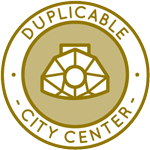 One Community is launching a collaborative of new sustainable living models through a Duplicable and Sustainable City Center that is LEED Platinum certified/Sustainable, can feed 200 people at a time, provide laundry for over 300 people, is beautiful, spacious, and saves resources, money, and space:
One Community is launching a collaborative of new sustainable living models through a Duplicable and Sustainable City Center that is LEED Platinum certified/Sustainable, can feed 200 people at a time, provide laundry for over 300 people, is beautiful, spacious, and saves resources, money, and space:
- Learn about this building and it’s function: Duplicable City Center Open Source Hub
Jason Bao (Architectural Designer) continued working on producing renders for the Duplicable City Center library. The human models were added to the lecture scene, and feedback from group members was addressed. Lecture scene renders were tested, finalized, and completed. Preparations for finalizing outdoor renders began according to Jae’s plan, with initial steps taken to merge files received from other team members. Files were merged and tested through trial image renders to verify compatibility. Progress on merging and rendering tasks was documented, and adjustments were made to ensure alignment with project requirements. The Duplicable City Center is a foundational part of One Community’s open-source model, which excels in launching a collaborative of new sustainable living models. This approach is integral to their mission of launching a collaborative of new sustainable living models through innovative and scalable solutions. See some of this work in the pictures below.
Mohammed Maaz Siddiqui (Architect) continued working on the cupola renders for the Duplicable City Center project. He optimized the Lumion file of the Duplicable City Center by removing, rearranging, and adding objects to the scene. He searched for 3D models suitable for rendering and updated the concert scene by replacing musician models and shifting focus to the top room while incorporating additional activity scenes. Within One Community’s open-source framework, the Duplicable City Center plays a central role in the mission of launching a collaborative of new sustainable living models. The images below showcase some of this work.
Manjiri Patil (Mechanical Design Engineer) continued redesigning the connector to simplify the creation of 2D drawings. She separated all the CAD files and worked on generating detailed 2D drawings for each one. She incorporated Jae’s suggestions into the One Community Reports and Tutorials and updated, refined, and organized the Excel sheet to ensure accuracy and completeness. The Duplicable City Center is a key part of One Community’s open-source plan for launching a collaborative of new sustainable living models. The images below showcase some of this work.
Nimika Devi (Architect) continued her contributions to the landscape design and development of the Duplicable City Center‘s urban farm. Efforts were directed toward working with a previous model due to technical issues encountered with the latest software version. Adjustments were made to the model’s textures based on received feedback to ensure accuracy and alignment with project requirements. These modifications addressed the identified concerns, making the model suitable for the next stage of visualization. The updated version was prepared for import into Lumion. Launching a collaborative of new sustainable living models relies on the Duplicable City Center, which is open-source and available to all. The images below showcase some of this work.
Rudrani “Sravya” Mukkamala (Mechanical Engineer) continued researching the structural components of a hydraulic elevator, focusing on the framework, guide rails, and load-bearing elements. She created a list of all parts of the subsystems, identifying whether each part needed to be manufactured or could be purchased off the shelf. This clarified the components required for the hydraulic elevator project and streamlined the sourcing process. After completing three subsystems in the list, attention shifted to the schematics of the hydraulic elevator as a key part of the DIY aspect of the project. Within One Community’s open-source framework, the Duplicable City Center plays a central role in the mission of launching a collaborative of new sustainable living models. The images below showcase some of this work.
Sanket Basannavar (Mechanical Engineer) continued working on the Duplicable City Center spa cover as part of the City Center Natural Pool and Eco-spa Designs. The four-panel spa cover design from the previous week was modified by determining the placement of the hinges. The current design does not fully cover certain sections of the pool, and adjustments were made to address this issue. Based on suggestions, an alternative eight-panel spa cover was also designed. Additionally, the total weight of the spa cover was reduced from 1,360 lbs to 629 lbs. One Community’s open-source Duplicable City Center design is essential to their goal of launching a collaborative of new sustainable living models. The images below showcase some of this work.
Yan “Jenni” Zu (Architectural Designer) continued her work on the greenhouse area of the Duplicable City Center. She made the final adjustments to the greenhouse renderings and performed high-resolution rendering from multiple angles. She refined the details of the interior and exterior, ensuring accurate lighting, realistic textures, and balanced composition. Various perspectives were rendered to showcase the greenhouse design. The adjustments included improving material reflections, optimizing shadows, and enhancing environmental elements for a more realistic effect. Jenni also worked on color correction and fine-tuned the final images to maintain consistency. The open-source Duplicable City Center is crucial for One Community as they work towards launching a collaborative of new sustainable living models. The images below showcase some of this work.
HIGHEST GOOD FOOD PROGRESS
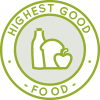 One Community is launching a collaborative of new sustainable living models through Highest Good food that is more diverse, more nutritious, locally grown and sustainable, and part of our open source botanical garden model to support and share bio-diversity:
One Community is launching a collaborative of new sustainable living models through Highest Good food that is more diverse, more nutritious, locally grown and sustainable, and part of our open source botanical garden model to support and share bio-diversity:
- Learn about the structures: Hoop House Hub | Aquapini & Walipini Open Source Hub
- See what we’ll be growing: Gardens & Hoop Houses | Large-scale Structures | Food Forest | TA
This week, the core team continued their review of the Master Tools, Equipment, and Materials/Supplies list. They added descriptive narratives to explain the function of various tools and identified the specific projects that would require their use. These descriptions covered tools such as hammers, pliers, toolboxes, tin snips, wrenches, a saber saw, a screw gun, an impact driver, and an impact wrench. The Highest Good Food initiative is a key component of One Community’s open source plans, focused on launching a collaborative of new sustainable living models, and exemplifies the organization’s commitment through innovative design and implementation. Below are some of the images showcasing this work.
Jay Nair (BIM Designer) continued working on Aquapini and Walipini Planting and Harvesting lighting and HVAC design. He continued updating the document format based on the latest review, ensuring consistency with project standards. Adjustments included modifying section layouts, refining text structure, and standardizing formatting across different sections. Additional changes were made to improve readability and organization, aligning the document with the required guidelines and expectations. Launching a collaborative of new sustainable living models includes Highest Good Food, an open source initiative demonstrating One Community’s commitment to transforming food production. Below are some of the images showcasing this work.
Jessica Fairbanks (Administrative Assistant) completed her edits to the project on the integration of Highest Good Food into small-scale organizations in preparation for a final review, and is awaiting feedback. She reviewed and prepared the current progress on the menu implementation tutorials to ensure a smooth handover for a new volunteer. She also reviewed the work of several admins and provided detailed feedback. In addition, she completed her regular administrative tasks and scheduled and completed an interview with a new volunteer. Highest Good Food is an open source project that plays a vital role in One Community’s efforts to launching a collaborative of new sustainable living models, emphasizing the importance of food sovereignty in our vision. Her contributions are highlighted in the collage below.
Kishorre Annanth Vijayan (Mechanical Engineer) finalized the planting layout for Walipini #1, ensuring the Burseraceae species were positioned on the south edge, carob trees were grouped for pollination, and Cyrtocarpa and argan trees were arranged for cross-pollination and optimal light exposure. Lighting needs for high-light plants were calculated, including estimating the required PPFD and determining the number of artificial lights needed. The greenhouse orientation was verified for maximum sunlight, and an irrigation system was planned for the arid climate, along with an assessment of energy-efficient lighting options and an estimate of annual energy consumption for lighting and temperature regulation. A report was created summarizing findings, including heat transfer calculations, energy modeling, and cost analysis to compare roof design scenarios. Lighting calculations for Walipini 1 and Walipini 2 were validated against Jay’s calculations. The greenhouse design was optimized by validating heating, cooling, and lighting calculations, reviewing passive thermal strategies such as the earthen roof and climate battery, and assessing irrigation and water management strategies, including drip irrigation and rainwater harvesting. All findings were compiled into a report that includes cost analysis and key conclusions. The Highest Good Food initiative is a key component of One Community’s open source plans, focused on launching a collaborative of new sustainable living models, and exemplifies the organization’s commitment through innovative design and implementation. Below are some of the images showcasing this work.
Pallavi Deshmukh (Data Analyst) reviewed team member’s work and incorporated their contributions to ensure completeness. This helped maintain alignment with project requirements, provided a clear overview of progress, and supported collaboration. A team member submitted fewer images than required, so a comment was left on their document to address the issue. Four interviews were completed, and issues related to Sunday’s work were resolved. Pallavi also reviewed the work of two team members and provided comments where improvements were needed. Some confusion regarding web design was clarified, and work continues. Launching a collaborative of new sustainable living models includes Highest Good Food, an open source initiative demonstrating One Community’s commitment to transforming food production. Her contributions are highlighted in the collage below.
Tanmay Koparde (Industrial Engineer And Team Administrator) optimized Food Procurement and storage to enhance efficiency and sustainability. He focused on sourcing from both local suppliers and large-scale distributors while implementing improved storage practices to maintain freshness and minimize waste. Later, he submitted his case study for a second review to Jae, making final adjustments by adding pictures and tables to enhance clarity and comprehension. Highest Good Food is an open source project that plays a vital role in One Community’s efforts to launching a collaborative of new sustainable living models, emphasizing the importance of food sovereignty in our vision. See his work in the collage below.
Vatsal Tapiawala (Mechanical Engineer) completed his research on HVAC load calculations for different zones and submitted his report for review. He also finalized the structural analysis of Walipini 1. He detailed considerations for different internal and external environments, analyzing their impact on thermal loads. He also collaborated with his teammate to calculate the total cost, ensuring that all factors affecting energy consumption and expenses were accounted for. As part of our commitment to launching a collaborative of new sustainable living models, One Community’s Highest Good Food initiative uses open source principles to promote sustainable food systems for all. See his work in the collage below.
HIGHEST GOOD ENERGY PROGRESS
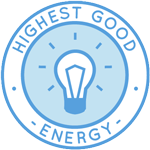 One Community is launching a collaborative of new sustainable living models through Highest Good energy that is more sustainable, resilient, supports self-sufficiency and includes solar, wind, hydro and more:
One Community is launching a collaborative of new sustainable living models through Highest Good energy that is more sustainable, resilient, supports self-sufficiency and includes solar, wind, hydro and more:
- Learn about the open source sustainable-energy foundations: Solar, Hydro, and Wind
- Explore our research into the most sustainable products and companies for saving water and energy: Insulation, Eco-laundry, Lightbulbs and Light Bulb Companies, Doors and Door Companies, Windows and Window Companies, Toilets, Faucets and Faucet Accessories, Urinals, and more.
This week, Dishita Jain (Data Analyst and Team Administrator) addressed multiple assignments within the Highest Good Energy and OC Administration projects. She verified the completeness of icon lists and search engine pages, examined sub-categories to determine if tutorial videos were needed, and analyzed spreadsheets to understand energy infrastructure cost analysis. To expand her understanding of the subject, she also consulted documentation and viewed related videos. Additionally, Dishita provided feedback to the training team and evaluated the work of other administrators, focusing on quality checks and data verification. The Highest Good Energy initiative is a key component of One Community’s open source plans, focused on launching a collaborative of new sustainable living models, and exemplifies the organization’s commitment through innovative design and implementation. Below are some of the images showcasing this work.
HIGHEST GOOD EDUCATION PROGRESS
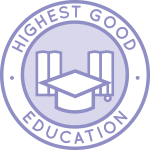 One Community is launching a collaborative of new sustainable living models through Highest Good education that is for all ages, applicable in any environment, adaptable to individual needs, far exceeds traditional education standards, and more fun for both the teachers and the students. This component of One Community is about 95% complete with only the Open Source School Licensing and Ultimate Classroom construction and assembly details remaining to be finished. With over 8 years of work invested in the process, the sections below are all complete until we move onto the property and continue the development and open sourcing process with teachers and students – a development process that is built directly into the structure of the education program and everything else we’re creating too:
One Community is launching a collaborative of new sustainable living models through Highest Good education that is for all ages, applicable in any environment, adaptable to individual needs, far exceeds traditional education standards, and more fun for both the teachers and the students. This component of One Community is about 95% complete with only the Open Source School Licensing and Ultimate Classroom construction and assembly details remaining to be finished. With over 8 years of work invested in the process, the sections below are all complete until we move onto the property and continue the development and open sourcing process with teachers and students – a development process that is built directly into the structure of the education program and everything else we’re creating too:
- Program Overview: Education Open Source Hub
- How the components work together in designing human orchestrated eco-abundance: How to use the Education for Life Program
- Lesson Plans for Life – Lesson Plans How-to
- Foundations of Outstanding Leaders, Teachers, and Communicators
- Curriculum for Life
- Teaching Strategies for Life
- Learning Tools and Toys for Life
- Evaluation and Evolution
This week, Bhavya Prakash (Software Engineer) continued her work on the Figma designs for the Highest Good Network software, where she created new structures and began implementing requirements. Instructions from Jae on WhatsApp were reviewed, and implementation started accordingly. Research was done to explore design ideas aligned with the requirements. Designs were created for student dashboards, logging interfaces, and course pages. Collaboration with Harshitha took place to discuss progress and refine the designs. The One Community model of launching a collaborative of new sustainable living models with sustainably built classrooms like this is an excellent example of sustainable change for the whole planet. See the collage below for her work.
Harshitha Rayapati (Program Manager) continued work on defining user classes, assigning features and permissions for each role, and charting user stories. Research focused on program evaluation goals and evolution tracking from the student’s perspective. High-level and phased deliverables were created for the education portal, covering student, teacher, learning support team, and project manager roles, and refined to align with the format of previous software phases. Deliverables were sequenced to support incremental progress and facilitate future assignments for mock-ups and development. Mrinalini’s inputs were reviewed and linked to corresponding project milestones. Additionally, training documentation for new team members was reviewed, with comments provided for components requiring corrections or rework to support the completion of their training process. This One Community classroom exemplifies how launching a collaborative of new sustainable living models can create positive change worldwide. See the collage below for her work.
Mrinalini Raghavendran (Software Engineer) continued working on researching and defining requirements for the Highest Good education software student dashboard. This week, she focused on evaluation styles and outlining high-level requirements. She defined initial frontend and backend requirements and refined them further. She structured different sections of the document, added more detailed requirements, and specified frontend and backend tasks before forwarding it to Jae for feedback. After receiving his comments, she made updates, noted areas needing clarification, and reached out to team members for input. Mrinalini also researched using various references to refine the document and continued improving the requirements. By launching a collaborative of new sustainable living models with classrooms like this, One Community provides a replicable example for global sustainable development. See the collage below for her work.
HIGHEST GOOD SOCIETY PROGRESS
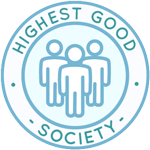 One Community is launching a collaborative of new sustainable living models through a Highest Good society approach to living that is founded on fulfilled living, the study of meeting human needs, Community, and making a difference in the world:
One Community is launching a collaborative of new sustainable living models through a Highest Good society approach to living that is founded on fulfilled living, the study of meeting human needs, Community, and making a difference in the world:
- Read the Highest Good society overview: Highest Good Society
- Learn about the model for fulfilled living and sharing: A Day in the Life
- Learn about the 4 economic models: RBE | For-profit | Non-profit | Entrepreneurship
- Learn about our open source community collaboration and management software: The Highest Good Network
This week, the core team completed over 59 hours managing One Community’s volunteer-work review not included above, emails, social media accounts, web development, new bug identification and bug-fix integration for the Highest Good Network software, and interviewing and getting set up new volunteer team members. They also shot and incorporated the video above that talks about launching a collaborative of new sustainable living models and how launching a collaborative of new sustainable living models are a foundation of the bigger picture of everything One Community is doing. The image below shows some of this work.
Anoushka Hazari (Data Analyst) continued working on code to automate and simplify the Highest Good Network software promotion process. She refined a Python script to extract and analyze pull requests (PR) and review data from a GitHub repository using the GitHub API. The script was improved with enhanced error handling, debugging outputs, and pagination to ensure complete data retrieval. Functions were developed to fetch PRs and reviews, process key metadata, and store the structured data in a CSV file for further analysis. She created a Tableau dashboard to visualize PR review activity, including top-reviewed PRs, reviewer contributions, and review distribution over time. Calculated fields were added to determine promotion eligibility based on inferred work hours, addressing the challenge of missing hour data. The dashboard was enhanced with filters and visual indicators for better insights. Additionally, she reviewed PRs, updated the PR review table, and onboarded new team members. She wrote and edited a blog post, designed a collage to accompany it, and corrected errors in a previous blog. The HGN spreadsheet was updated, and peer blogs were reviewed in Sheet 4. She also recorded Loom videos documenting her progress on the dashboard and assigned tasks for Jae. This work helps One Community’s mission of launching a collaborative of new sustainable living Models and reinforces our commitment to launching a collaborative of new sustainable living Models. The following images show her work for the week.
Chitra Siddharthan (Data Analyst and Team Administrator) continued focusing on the existing web pages of the HGN Phase II website. This week, Chitra focused on updating the weekly summary, blog, and Dropbox files for team Code Crafters for week 622, and addressed Dhrumil’s doubts regarding his Phase 2 task, which involved researching related web pages and their connection to his work. Researched the Issue Log Form at Ziddi’s request, compiled questions, sent them to Jae for confirmation, and added the task accordingly. Responded to Vinay on Slack. She researched the Tool/Equipment Update Log and tested the “Purchase Request: Materials (FE 2764)” page, identifying a query about the Approval/Rejection option, which was recorded and sent to Jae. Brainstormed ideas based on Jae’s input regarding the purchase request process. Tested “Purchase Request: Reusables (FE 1979),” found an issue with the purchase request button, and assigned the task to Dhrumil. Worked on backend code locally due to issues retrieving input data during execution. Explored Jae’s idea related to the Purchase Request page. Addressed Phase 2-related messages for Ziddi and responded to Sai Preetham’s query regarding Phase 2 tasks. Tested PRs FE 1979 (Purchase Request: Reusables), FE 1956 (Reusables List View), and PR 2389 (Update Reusable – Bulk), updating their working status in the Phase 2 tracking document. Tested PRs related to consumables pages in Phase 2, recording observations on their status and functionality, including Consumables: Bulk Updates (FE 1925), Consumables: Purchase Request (FE 2018), Consumables: Add, and Consumables: List (FE 1758). Tested Inventory Types: Edit (PR 1984/765) and updated the page status. Had a Zoom meeting with Jaiwanth to address his queries about the Phase 2 Figma Dashboard. Marked new action items in the Phase 2 document and assisted Ashrita with her assigned task. This work helps One Community’s mission of launching a collaborative of new sustainable living Models and reinforces our commitment to launching a collaborative of new sustainable living Models. The following images show her work for the week.
Feras Rehman (Data Analyst) continued working on developing One Community’s Mastodon account and strategy. He scheduled six more Mastodon posts on Buffer for the following week. Targeted strategies were developed and implemented, resulting in a 5x increase in post reach through optimized hashtag usage and improved post structuring. Additionally, five more Mastodon posts were scheduled on Buffer for the following weeks. A weekly summary review was completed, and images were added to supplement the summary. This work helps One Community’s mission of launching a collaborative of new sustainable living Models and reinforces our commitment to launching a collaborative of new sustainable living Models. The following images show his work for the week.
Govind Sajithkumar (Project Manager) started working on social media posting, analytics, and strategy evolution for the Meta (Facebook and Instagram) platforms. He accessed the One Community Facebook and Instagram pages, explored the dashboards, and reviewed the posting procedures and tracking spreadsheets. He created and scheduled multiple unique posts for both platforms, recording post times, content types, and focus categories in the Open Source Social Media Design Spreadsheet. Govind also reviewed the Meta Analytics Report and Tracking Sheet to understand its purpose and set up the necessary tracking tools based on the provided documentation. Additionally, he provided feedback on training documents, updated his training materials, and completed administrative tasks related to team management and process updates. This work helps One Community’s mission of launching a collaborative of new sustainable living Models and reinforces our commitment to launching a collaborative of new sustainable living Models. The following images show her work for the week.
Hritvik Mahajan (Data Analyst) continued focusing on multiple tasks related to marketing, promotion, software development, social media strategy, and administrative activities. As part of the marketing and promotion tasks, he managed Twitter’s social media posting and strategy, posting content across communities and testing engagement by reposting high-performing posts. In software development, he focused on Phase 1 software frontend testing, reviewing pull requests, identifying bugs, and coordinating with team members regarding changes and merge conflicts. His administrative responsibilities included reviewing the training work of new admin team members, identifying mistakes in submitted reviews, and providing feedback. He also contributed to the OC Administration team by reviewing and commenting on admin team members’ work for a blog post, creating collages, summarizing team contributions, and covering work for a past post. This work helps One Community’s mission of launching a collaborative of new sustainable living Models and reinforces our commitment to launching a collaborative of new sustainable living Models. The following images show his work for the week.
Jaiwanth Reddy Adavalli (Project Manager) worked on multiple projects, completing PR admin team training and orientation. As part of the training review team, he reviewed the work of new volunteers. In his role managing the Highest Good Network Phase 2 dashboard, he read project documentation to understand its current state, discussed goals with Jae and Chitra, and examined the dashboard to identify areas for improvement. He explored Figma features that could enhance the dashboard, reviewed dashboards from other phases to understand page flow, created two wireframe pages, and added multiple action item candidates to the dashboard collaboration document. This work helps One Community’s mission of launching a collaborative of new sustainable living Models and reinforces our commitment to launching a collaborative of new sustainable living Models. The following images show his work for the week.
Raghav Dinesh Pamuru (Product Manager) continued focusing on designing and building a Google Sheets dashboard to simplify tracking and analyzing social media engagement, integrating data from multiple sources. He coordinated with all team members to develop a master dashboard for social media engagement, ensuring alignment on data sources, key metrics, and reporting structure. He facilitated discussions to gather input on required features, organized data collection processes, and collaborated on structuring the dashboard for accessibility and usability. Additionally, he worked with stakeholders to refine the layout and functionality, ensuring it met the team’s needs for tracking engagement and performance across platforms. This work helps One Community’s mission of launching a collaborative of new sustainable living Models and reinforces our commitment to launching a collaborative of new sustainable living Models. The following images show his work for the week.
Rahul Bavanandan (Data Analyst) continued working on several key projects within the Highest Good Network software, One Community’s Reddit presence, and administration. He focused on the HGN Phase 2 Evolution project Figma Visualizations, incorporating feedback provided by Jae. His work also included tasks related to OC Administration. He consolidated all administrators’ blogs into the main blog, generated a PDF of the complete page, and identified areas lacking justification before relocating the content. Additionally, he accessed the blog from the Defining Our Avatar page, verified the version number, and optimized the blog using the RankMath Tutorial for enhanced SEO integration. This work helps One Community’s mission of launching a collaborative of new sustainable living Models and reinforces our commitment to launching a collaborative of new sustainable living Models. The following images show his work for the week.
Yash Shah (Data Analyst and Team Administrator) continued his admin work and managed the social architecture component of the Highest Good Network software. He assisted the team in understanding their assigned tasks, ensuring that most tasks in Phase 3 were allocated. A list of completed pull requests was compiled and sent to Jae. He connected with Anjali to help her understand her assigned task and provided relevant references to address a development issue. Anjali was assigned a new task to optimize follow-up email templates. Yash also coordinated with Vaibhavi to explain backend metrics and adjusted her allocated hours to accommodate additional changes to existing work. A blog was created for Dev Dynasty, and the weekly folder was organized. Additionally, a collage was put together, and feedback was provided on fellow volunteers’ blogs. This work helps One Community’s mission of launching a collaborative of new sustainable living Models and reinforces our commitment to launching a collaborative of new sustainable living Models. The following images show his work for the week.
Zuqi Li (Administrative Assistant and Economic Analyst) continued managing One Community’s LinkedIn page. She explored LinkedIn Analytics documentation, analyzed dashboards to track project progress, and updated key metrics. She also refreshed dashboards, reviewed post-editing documentation, and planned content for the upcoming week. Additionally, she met with Pershka to improve LinkedIn Analytics tasks, selected hashtags for LinkedIn posts, and scheduled daily posts to enhance engagement. Zuqi also reviewed and organized weekly summaries for the Graphic Design and Alpha Teams, providing feedback as needed. This work helps One Community’s mission of launching a collaborative of new sustainable living Models and reinforces our commitment to launching a collaborative of new sustainable living Models. The following images show her work for the week.
ADMINISTRATION TEAM
The Administration Team A-Z summary, covering their work administrating and managing most of One Community’s ongoing process for designing global game-changing cooperatives was managed by Mimansha Kaushik (Data Analyst Team Administrator) and includes Himanshu Mandloi (Engineering Project Manager), Jibin Joby (Data Analyst), Kishan Sivakumar (Administrative Assistant and Software Team Manager), Olawunmi “Ola” Ijisesan (Administrative and Management Support), Preksha Welankiwar (Digital Marketing Manager), Rachna Malav (Data Analyst), Ratna Meena Shivakumar (Data Analyst and Admin), Ryutaro Wongso (Economic Analyst and Team Administrator), Saumit Chinchkhandi (Administrative Assistant and Software Engineer), Shrinivas Patil (Software Engineer), Sneka Vetriappan (Data Analyst), Vikas Pande (Software Administrator) and Vishnu Murali (Data Analyst). The Highest Good Network software is how we’ll be managing and objectively measuring our process for launching a collaborative of new sustainable living models through our social architecture, construction, production, and maintenance processes.
This week, Himanshu focused on orientation and initial setup, completing all four training steps, addressing administrative feedback, and working through Steps 1 to 4 of OC Administration. He revisited instructional videos for clarity, made adjustments to the WordPress blog, and reviewed the “Congratulations, You’re An Admin Now!” document, laying the groundwork for launching a collaborative of new sustainable living models. Jibin reviewed the housing team’s work, created collages, updated the assigned page, and provided feedback for improvements. He collaborated with Vishnu to extract data from BlueSky using the BlueSky scraper, organized it in Google Sheets, and generated visuals on One Community’s account activity. He also managed daily posts on the BlueSky account, increasing the follower count to 20, and met with Raghav to discuss integrating visuals into the Master Dashboard. Kishan focused on senior admin duties, reviewed volunteer documents, tracked progress, and addressed requests. He reviewed SEO pages, completed final checks and edits, and began working on new admin tasks while revisiting previously optimized pages based on peer feedback. His contributions extend to supporting the broader organization’s goals, including launching a collaborative of new sustainable living models.
Mimansha worked on OC Administration and Orientation and Initial Setup tasks, addressing feedback, modifying content, and reviewing training steps for clarity. She revisited videos and documents to ensure alignment with requirements and made adjustments in response to ongoing feedback, all while launching a collaborative of new sustainable living models. Olawunmi supervised managers overseeing Pull Request (PR) review teams, provided feedback, and monitored the HGN progress summary report. He onboarded and trained new PR team managers, analyzed their performance, and updated the summary report with images. Preksha managed engagement on Threads, Instagram, and LinkedIn, suggested new social media strategies, and proposed a cross-promotion strategy for Threads. She interviewed two candidates for One Community, updated the hiring workbook, and provided training feedback to Himanshu and Mimansha. Rachna had a slower week as most interview requests were taken by other admins, so she worked on pending SEO pages, checked prior work, and stayed updated via emails and comments. This allowed her to explore new avenues for content creation, including launching a collaborative of new sustainable living models.
Ratna prepared a weekly summary, created blog collages, scheduled Facebook and Instagram posts, and developed social media dashboards. She met with Raghav to discuss social media dashboards and contributed to the AI music creation sheet. Ratna’s diverse contributions, from social media management to creative projects, are essential to launching a collaborative of new sustainable living models. Ryutaro worked on cost analysis for missing components of the duplicable city center, maintained details from the general contractor document, and began weekly OC administrative tasks, including reviewing the Binary Brigades Software Team’s work. Saumit managed the pull request workflow for volunteers with first names between A and H, reviewed submissions, provided feedback, and performed frontend testing on multiple PRs. He also updated his WordPress page, interviewed two software team volunteers, addressed PR training and onboarding questions, and provided Jae with an update on the Total Org Summary dashboard, all while laying the groundwork for launching a collaborative of new sustainable living models.
Shrinivas completed blog 621 for Team Moonfall, provided feedback to team members, assisted with the admin feedback spreadsheet, and continued researching time use datasets for full-time employees. He analyzed data from four sources, continued documentation, and gathered additional data points, all while exploring the feasibility of launching a collaborative of new sustainable living models. Sneka reviewed time log entries for accuracy, followed up on comments for clarity, provided feedback to five colleagues, added weekly summaries and collages, and ensured conditions on the review table were met. Vikas focused on training team review, hiring processes, and refining training materials. He rescheduled an interview, sent follow-ups, assessed hiring criteria, reviewed documents from Mimansha and Himanshu, and completed his final training step by reviewing other administrators’ work. Vishnu met with Raghav to discuss integrating visuals into the Master Dashboard, collaborated with Jibin to extract and organize BlueSky data, reviewed Lucky Star team members’ work, and managed daily BlueSky posts, increasing the follower count to 20. See the Highest Good Society and the Highest Good Network pages to learn more on how their work contributes to launching a collaborative of new sustainable living models. See below to view images of their work.
GRAPHIC DESIGN TEAM
The Graphic Design Team’s summary was managed by Harshitha Rayapati (Program Manager) and includes Aurora Juang (Graphic Designer), Jaime Yao (Creative Technologist), and Junyuan Liu (Graphic Designer, UI/UX Designer), covering their work on graphic designs for launching a collaborative of new sustainable living models. This week, Aurora created additional icons for the vermiculture toilets and designed new icons for each chapter of the website. She finalized social media campaign images and submitted them for Jae’s approval. She also worked on social media content creation posts from Google Sheets, including posting new bios for volunteers. This involved revising errors to ensure accuracy and crafting new bio announcements. She streamlined team processes to improve the overall quality of resources available for new volunteers, contributing to launching a collaborative of new sustainable living models.
Jaime redesigned social media images for the themes “What Can We Do to Make the World a Better Place,” “Every Act of Kindness Makes a Difference,” and “Together, We Can Make a Difference for Future Generations.” The updates focused on improving clarity, visual impact, and alignment with messaging on sustainability, community engagement, and environmental responsibility. Each design aimed to enhance communication effectiveness and encourage action, contributing to launching a collaborative of new sustainable living models. Junyuan created social media content by collecting images and exploring design options in design software. Three new social media images were completed through an iterative process, and initial steps were taken to search for images and develop design ideas for the next image. Additionally, he brainstormed approaches for future image creation. See the Highest Good Society pages for more on how this contributes to launching a collaborative of new sustainable living models. See the collage below to view some of their work.
HIGHEST GOOD NETWORK PROGRESS
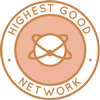 One Community is launching a collaborative of new sustainable living models through open source Highest Good Network® software that is a web-based application for collaboration, time tracking, and objective data collection. The purpose of the Highest Good Network is to provide software for internal operations and external cooperation. It is being designed for global use in support of the different countries and communities replicating the One Community sustainable village models and related components.
One Community is launching a collaborative of new sustainable living models through open source Highest Good Network® software that is a web-based application for collaboration, time tracking, and objective data collection. The purpose of the Highest Good Network is to provide software for internal operations and external cooperation. It is being designed for global use in support of the different countries and communities replicating the One Community sustainable village models and related components.
- Learn about our open source community collaboration and management software: The Highest Good Network
This week, the core team continued their work on the Highest Good Network PRs and confirmed fixes for several issues, including restoring toolbar visibility in time logging modals (#3143), resolving a bug in the Team Member Tasks Table (#3062), retrieving profile images from the website (#2714), and fixing the Last Day error (#3075). Issues that remained unresolved included creating a new team member in Phase 2 (#3035), fixing the team code requirement for creating new users (#2845), and addressing a dashboard viewing issue (#3074). Additionally, core team assigned tasks to seven volunteers and recorded a video detailing errors, along with an accompanying image, for the team code requirement fix (#2845). These improvements represent incremental steps towards the realization of launching a collaborative of new sustainable living models. See the Highest Good Society and Highest Good Network pages for more on how this relates to launching a collaborative of new sustainable living models. The collage below shows some of their work.
ALPHA SOFTWARE DEVELOPMENT TEAM
This week, the Alpha Team’s summary, covering their work on the Highest Good Network software, was managed by Lin Khant Htel (Frontend Software Developer) and the team includes Eve Ye (Volunteer Software Engineer Intern), Jiaqi Nie (Software Engineer), Sheetal Mangate (Software Engineer), Sujith Reddy Sudini (Full-Stack Software Developer), Rupa Rajesh Bhatia (Software Engineer), and Vinay Vallabineni (Software Engineer).
Eve implemented the createPin functionality for Pinterest and made improvements to the authentication process. For the authentication adjustment, she stores the Pinterest token and its expiration time in a file. The system checks the file for a valid token before use; if expired or unavailable, it triggers the authentication process to obtain and save a new token. Regarding the createPin functionality, due to limitations with the trial account, the Pinterest sandbox API is being used. The env file has been configured with Pinterest Sandbox API. Once standard access is obtained in the production environment, this flag will be changed to false with no further changes required, launching a collaborative of new sustainable living models.
Jiaqi focused on optimizing the app for the Safari browser. He reviewed each web page and addressed warnings related to HTML rule violations, such as ensuring that a table is not a child of a <tr>. This process involved identifying and correcting structural issues to improve compatibility and functionality. Before starting this task, he also reviewed four pull requests: PR3168, PR3169, PR3171, and PR3173, examining the proposed changes and providing feedback where necessary. Jiaqi’s work on optimizing the app for Safari, along with his attention to code review, contributes to launching a collaborative of new sustainable living models.
Rupa enhanced the multi-step form project by improving its responsiveness across various devices. She maintained a cohesive design using modular principles and customized visual elements. She incorporated sliders, custom input fields, and toggle switches to boost interactivity, all efficiently managed through dynamic state handling. Additionally, she optimized navigation for seamless transitions while preserving user data and implemented real-time validation to ensure data accuracy. Rupa also introduced custom features, including digital signatures and user preferences. As part of her managerial training, she analyzed workflows and reviewed Lin Khant Htel’s project to strengthen her skills. She collaborated with Eve, Jiaqi, Sheetal, Sujith, and Vinay to refine the project summaries and enhance overall functionality, launching a collaborative of new sustainable living models.
Sheetal continued working on the ‘Development for Re-Engagement Strategies’ task from HGN Phase III. She worked on setting routes and testing them through Postman. Additionally, she focused on the email functionality, checking for bulk email sending functionality, and started working on designing the UI to display the no-show rate tracking model popup. This work contributes to launching a collaborative of new sustainable living models by improving member engagement and retention. Sujith worked on enhancing the Resource Management component for the Highest Good Network App. He addressed ESLint errors, improved code quality, and resolved issues related to button attributes and array indexes. After refining the UI and optimizing pagination, he raised PR #3128 and is now looking for a new task. Vinay worked on a bug in the permission management list where empty logs were appearing even when no permissions were added or removed. After investigating the issue, two cases were identified as the cause, and both were fixed in the API. Additionally, the auto-refresh of the logs list was fixed to update properly upon the successful submission of a user permission log, launching a collaborative of new sustainable living models. See below for some of the team’s work.
BINARY BRIGADE SOFTWARE DEVELOPMENT TEAM
The Binary Brigade Team’s summary overseeing advancements in the Highest Good Network software was managed by Vijay Anand Pandian (Full Stack Software Engineer) and includes Aaryaneil Nimbalkar (Software Developer), Anirudh Sampath Kumar (Software Developer), Deepthi Kannan (Software Engineer), Geeta Matkar (Software Engineer), Sabitha Nazareth (Software Engineer), Sriram Seelamneni (Software Engineer), and Sunil Kotte (Full Stack Developer). The Highest Good Network software is how we’ll be managing and objectively measuring our progress in launching a collaborative of new sustainable living models through our social architecture, construction, production, and maintenance processes.
This week, Aaryaneil integrated the backend APIs with the frontend developed by Sabitha and tested their functionality. Work was done on resolving issues with the Dropbox API after testing the endpoints. As part of launching a collaborative of new sustainable living models, a video was created for Jae to review the program, and additional testing was conducted to identify and fix API-related issues. Merge conflicts and other issues with previous pull requests were resolved to ensure they could be merged. Anirudh worked on a bug where the timer for logging hours was allowing duplicate entries instead of resetting after a single log. He attempted to replicate the issue in the local environment through testing but was unable to reproduce it. His efforts also aligned with launching a collaborative of new sustainable living models, as he reviewed multiple pull requests, verifying code quality and performing necessary testing. The pull requests he reviewed included PRs 3119, 3122, 3158, 3167, 3168, 3171, 3173, 3175, 3177, and 3178.
Deepthi worked on refining the Leaderboard Header by addressing requested changes in the PR. She repositioned the info icon (EditableInfoModal) next to “Name” using flexbox for improved alignment and adjusted spacing. Additionally, as part of the broader initiative tied to launching a collaborative of new sustainable living models, she fixed an issue where the “Name” text disappeared due to included changes, ensuring visibility while preserving abbreviations. She also worked on existing issue #2246 and addressed further requested changes. Geeta completed admin training and reviewed all related documentation to understand the workflow for administrative tasks. She continued working on the header task, which includes an existing pull request, PR 2987. While resolving merge conflicts in the code, she also tackled additional issues with header height, a task that is connected to launching a collaborative of new sustainable living models. Work on header height began last week and is expected to be completed this week. Errors related to Node and width adjustments were encountered and are being addressed.
Sabitha worked with Aaryaneil to complete the assigned tasks, but progress was slower than expected due to issues in the backend. To address these challenges, she is creating a detailed video explaining the problems and will send it to Jae. This documentation effort contributes to launching a collaborative of new sustainable living models by ensuring transparency and clear communication. She has requested extra hours from Jae. Sriram worked on optimizing loading times in the WBS system by identifying inefficiencies in the code that contributed to slow performance, particularly when handling a large number of items, and reviewed the code to determine areas causing delays. His work directly supports launching a collaborative of new sustainable living models by improving efficiency in system operations. He also resolved merge conflicts for another task due to new updates. For the “Owner Manage All Permissions” task, he updated the hasPermission functionality based on feedback to align with recent changes.
Sunil worked on a bug related to displaying deactivated team members in the Weekly Summaries Reports. Previously, deactivated users were excluded from the reports, leaderboard, and other areas, preventing them from receiving credit for their final contributions. Ensuring fairness in tracking contributions is a key element of launching a collaborative of new sustainable living models, so he analyzed the code structure, debugged the backend logic, and identified that the report aggregation was filtering only active users. He modified the aggregation logic to include deactivated users in the “last week” tab and implemented frontend changes to display a clear indicator in the “Name” and “Role” fields, stating that the team member is no longer active.
Vijay worked on implementing unit tests for the bmInventoryTypeController file as part of the HGN software project, focusing on verifying the functionality and correctness of the controller. His commitment to improving test coverage also aligns with launching a collaborative of new sustainable living models, ensuring system stability and reliability. He also completed the unit test implementation for the bmDashboardController file, enhancing the test coverage and improving code reliability. See the Highest Good Society and Highest Good Network pages for more on how this relates to launching a collaborative of new sustainable living models. View some of the team’s work in the collage below.
BLUE STEEL SOFTWARE DEVELOPMENT TEAM
The Blue Steel Team’s summary, presenting their work on the Highest Good Network software was managed by Nazanin Hashemian (Software Developer, Team Manager) and includes Ramakrishna Aruva (Software Engineer), Sai Girish Pabbathi (Software Engineer), Sharan Sai Marpadaga (Software Developer), and Srichand Medagani (FullStack Developer). The Highest Good Network software is how we’ll be managing and objectively measuring our process for launching a collaborative of new sustainable living models through our social architecture, construction, production, and maintenance processes.
This week, Ramakrishna attempted to replicate an issue using a manager account instead of an admin or owner account but was still able to create, delete, and update tasks without encountering the reported problem. He tested various scenarios but was unable to reproduce the error. Ramakrishna’s contribution aids in launching a collaborative of new sustainable living models by ensuring the smooth operation of task management systems crucial for such initiatives. He worked on a new bug related to an error popup appearing in the user management section for new volunteers, identified React warnings, and traced the issue to the teamCode. To resolve this, he retrieved the teamCode from an alternative source instead of the weekly summary and planned additional test runs for verification. A navigation bar was created for the lbdashboard/listingshome page based on the provided document, along with routing for the same page by Sai. The basic structure was designed using CSS and HTML, but further modifications are needed to integrate the React frontend and backend APIs.
Sharan focused on debugging the blue square task, identifying issues in the cron jobs and continuing investigations to determine the root cause. Testing the scheduler for blue square issuing confirmed that it functions as expected, but additional checks are needed to understand why it does not work in normal scenarios. His contributions are essential for launching a collaborative of new sustainable living models. Srichand worked on optimizing the application for Chrome by running the code in VS Code, executing the application, and inspecting console logs for errors across different pages. Several issues were identified, including missing or duplicate key props in lists causing unnecessary re-renders in React, uncontrolled component warnings due to form elements having null values instead of empty strings, excessive console logs cluttering debugging output, and API request failures resulting in 404 or 500 errors.
Inefficient state updates and re-renders were also observed due to improperly managed dependencies in useEffect, leading to performance slowdowns. Srichand’s contributions to application optimization are vital for launching a collaborative of new sustainable living models by ensuring a smooth and efficient user experience. All console errors were documented for future fixes, with planned tasks including resolving console warnings, removing unnecessary logs, ensuring unique key props for optimized re-renders, validating controlled component values to prevent UI inconsistencies, and investigating API failures for proper error handling. ChatGPT was used to understand some error messages and their impact on performance.
Nazanin worked on the ReviewButton component, which provides different actions based on the review status. When the status is “Unsubmitted,” a button appears that opens a modal for users to add a related work link and submit the task. When the status changes to “Submitted,” a dropdown menu provides options to view the related work link (if available), mark the task as complete and remove it (for specific roles), or reset the status to “Unsubmitted” if more work is needed. This improvement streamlines the review process and facilitates a more efficient workflow, contributing to launching a collaborative of new sustainable living models. The deleteSelectedTask function was reviewed, confirming that it permanently removes tasks from the system, making it impossible to track who deleted them. Two components, TeamMemberTasks and Tasks, were created from TeamMemberTask and are rendered based on dropdown selection. An issue was identified where the resolvedBy field does not display any name or valid value for completed tasks. See the Highest Good Society and the Highest Good Network pages to learn more on how their work contributes to launching a collaborative of new sustainable living models. See below to view images of their work.
CODE CRAFTERS SOFTWARE DEVELOPMENT TEAM
The Code Crafters Team, covering their work on the Highest Good Network software, was managed by Summit Kaushal (Backend Software Developer) and includes Anjali Maddila (Software Engineer), Denish Kalariya (Software Engineer), Dhrumil Dhimantkumar Shah (Software Engineer), Humera Naaz (MERN developer), Pavan Swaroop Lebakula (Software Engineer) and Pratyush Prasanna Sahu (Software Engineer). The Highest Good Network software is how we’ll manage and objectively measure our process for launching a collaborative of new sustainable living models through our social architecture, construction, production, and maintenance processes.
This week, Anjali worked on designing email templates and engaged in one-on-one discussions with the manager to gain additional insights about the task. She also focused on resolving lint and build errors from previous pull requests, addressing the issues and ensuring the code met the required standards. Lint issues were resolved. Anjali’s attention to detail in code quality aligns with the broader organizational goal of launching a collaborative of new sustainable living models. Denish implemented performance optimization techniques such as resource preloading, asset compression, and code streamlining to reduce page loading time. While these efforts led to some improvement, the results did not meet expectations. Recognizing the interconnectedness of performance and user experience, Denish is now exploring the potential of launching a collaborative of new sustainable living models to further enhance the platform’s overall efficiency and impact.
Dhrumil worked on the 717 Phase 2: Tool/Equipment History (List of Issue Log), addressing various questions and clarifications related to the task. Additionally, he selected a new task aligned with his previous work and began working on the 719 Changes to Purchase Request: Reusables. Alongside these responsibilities, he focused on resolving merge conflicts in one of his pull requests to maintain code consistency and integration. This proactive approach to development contributes to launching a collaborative of new sustainable living models. Summit reviewed a GitHub conflict, but no conflicts were visibly detected despite their presence. He worked on locating the conflict and making necessary code adjustments. An important aspect that checks for duplicate badges was mistakenly removed and was subsequently restored. He also identified an issue with the parameters of increaseBadgeCount and addBadge, leading to necessary modifications. A call to increaseBadgeCount was removed after resolving the parameter issue, as it was no longer needed. These changes may be related to resolving the GitHub conflict. Summit’s contributions, including the restoration of the duplicate badge check and the parameter adjustments, contribute to the broader goal of launching a collaborative of new sustainable living models.
Humera oversaw issues and conflicts related to PR 1208. She addressed an edge case for incrementing a badge within the same week and adding a new badge for a higher streak while decrementing the lower badge. During the PR review, it was noted that the badge was still incrementing when the API was triggered, even when no changes were made to savedTangibleHrs. She is investigating whether this behavior is intended or needs to be resolved by reviewing documentation and consulting with superiors. This exploration of system behavior mirrors the innovative spirit of launching a collaborative of new sustainable living models. Additionally, she worked on the bell notification for meetings and found that userProfile data was empty instead of containing the necessary information. She is making backend changes to send the function directly with meeting details.
Pavan fixed the member column filter by providing an API to store projects sorted based on active members on the backend and integrated the functionality on the frontend. A different approach was taken instead of the previous work done by Anne. A tooltip text was added, and a mouse hover text still needs to be included before deployment. Pratyush refined style changes and attempted to add new functionality beyond the Figma design. He fixed styling and lint issues and implemented a feature to track repeated users. UI improvements included adding two colors to differentiate between registered and attended users. Labels were added to the pie charts, and initial testing was done with Material UI components, but it was determined that the library was not installed on the main branch. He created pull requests PR 3192 and PR 3194, with all checks passing. See the Highest Good Society and Highest Good Network pages for more on how this relates to launching a collaborative of new sustainable living models. View some of the team’s work in the collage below.
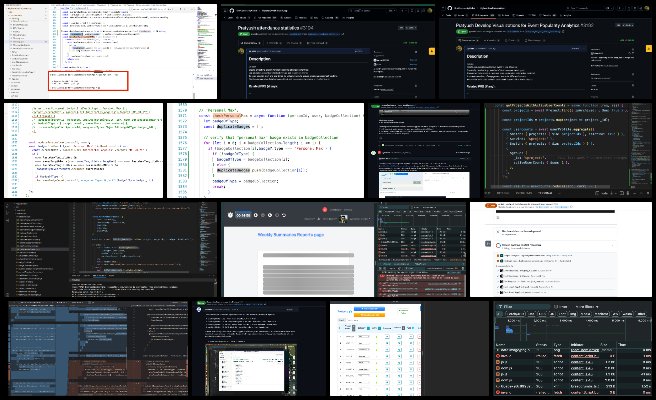
DEV DYNASTY SOFTWARE DEVELOPMENT TEAM
The Dev Dynasty Team’s summary, covering their work on the Highest Good Network software, was managed by Jatin Agrawal (Software Engineer) and includes Honglin Chen (Software Engineer), Ghouse Shahe Meera Ziddi Mohammad (Software Engineer Intern), Michael Lambo (Software Developer), Nikita Kolla (Full Stack Developer), Nishita Gudiniye (Software Engineer), Shraddha Shahari (Software Engineer) and Zhifan Jia (Software Engineer). The Highest Good Network software is how we’ll manage and objectively measure our process for launching a collaborative of new sustainable living models through our social architecture, construction, production, and maintenance processes.
This week, Honglin optimized the “add material to material list” pull request, fixing the update functionality and adding a more robust navigation dialogue under PR 3158. This work contributes to launching a collaborative of new sustainable living models by improving the user experience for those working with material selection. PR 3179 was raised, and work began on optimizing the application for the Opera browser. Several paths were checked and fixed, including registration, login, profile setup, password reset, email subscription and unsubscription, collaboration, logout, forced password updates, and various dashboard views. Ziddi created two pull requests, one for the frontend and another for the backend, to implement a form for users to log issues with MET. The form includes a submit button integrated with a RESTful POST API developed in the backend, along with a GET API to retrieve issue data. The frontend pull request builds on an existing one, incorporating review comments and modifying the code to address the recommended changes, while backend updates included modifications to unused files. This contribution from Ziddi facilitates user feedback, a crucial element in launching a collaborative of new sustainable living models.
Jatin worked on correcting percentage and value calculations in the people report and created a pull request for it. He also resolved merge conflicts in linking the HGN form with the main application, which caused the app to break, requiring additional changes to the application. His contributions are essential for launching a collaborative of new sustainable living models, as accurate data and a functional application are crucial for such an initiative. Michael adjusted the user management page so that the Title column maintains a fixed width, truncating longer titles and displaying the full text on hover. He began developing the Weekly Progress Update email template and send functionality, implementing a tabbed view that allows users to switch between the new formatted interface and the existing non-formatted view, and created the initial user interface for the new display. This work lays the groundwork for launching a collaborative of new sustainable living models by improving the platform’s communication and user experience.
Nishita worked on the “ENGAGEMENT TAB” of the event management page, focusing on the “comments” and “feedback” sections. She implemented the toggle functionality between tabs, developed the “comments” section, added the frontend for the “feedback” section following Figma mockups, and included placeholders for the search bar, filter, and sort buttons. She also updated the routes to ensure the URL changes based on the selected tab. This work lays the groundwork for launching a collaborative of new sustainable living models by improving user interaction and feedback mechanisms on the event management page. Nikita worked on the backend for the task “Create Weekly Company Summary Email for Admins,” focusing on developing the data pipeline to send data to the frontend for the Highest Good Network app, ensuring correct formatting, accessibility, and integration with the necessary components, all while the company is launching a collaborative of new sustainable living models.
Shraddha worked on resolving issues related to the incorrect function for assigning a new badge and the selection and saving of featured badges. While progress was made in analyzing the bug and identifying its root cause, the issues remain unresolved due to various errors encountered during debugging. This work is crucial for launching a collaborative of new sustainable living models that recognize and reward positive contributions. Zhifan designed the database structure for event tracking, researched Redux, and worked on optimizing dark mode. Testing was performed, and a pull request was completed. Zhifan responded to assistance requests on Slack and reviewed feedback on previous pull requests, making adjustments based on identified issues. Additionally, a new task was reviewed, with an investigation into the existing implementation to identify areas requiring attention. See the Highest Good Society and Highest Good Network pages for more on how this relates to launching a collaborative of new sustainable living models. View some of the team’s work in the collage below.
EXPRESSERS SOFTWARE DEVELOPMENT TEAM
The Expressers Team’s summary, covering their work on the Highest Good Network software, managed by Strallia Chao (Software Engineer), includes Jinda Zhang (Software Engineer/Machine Learning Engineer) and Rahul Trivedi (Software Engineer). The Highest Good Network software is how we’ll manage and objectively measure our process for launching a collaborative of new sustainable living models through innovative software development, testing, and collaboration.
This week, Jinda focused on implementing unit tests for various action creators within the index.js file. The newly added tests ensured that functions such as clearUserProfile, getUserTeamMembers, getDashboardData, getAllProjects, and postTimeEntry dispatched the correct actions with expected payloads. These tests enhanced frontend stability while linking with backend functionality that supported user profiles, teams, projects, and time entry retrieval. To verify these updates, users checked into the relevant branch, ran npm install, cleared site data/cache, logged in as an admin user, and confirmed proper functionality across different sections, including dashboard and tasks. Compatibility with dark mode was also tested and verified. Jinda’s work on robust testing contributes to a more reliable platform, which is essential for launching a collaborative of new sustainable living models.
Rahul reviewed several pull requests, focusing on UI fixes, test validations, and functionality improvements. In PR 3157, he confirmed that the start and end dates on the Reports page matched those on the User Management page across both light and dark modes. PRs 2988, 3167, 3173, and 3175 were verified to ensure all test cases passed. In PR 3163, he noted that the ‘i’ icon was now clickable, but the popup modal’s UI and alignment still required adjustments, and text was not visible in dark mode. This attention to detail exemplifies the kind of collaborative spirit crucial for launching a collaborative of new sustainable living models. In PR 3169, he checked that the new user form validation followed the correct order, with each required input displaying a toast message for invalid entries. In PR 3168, he verified that theme changes synced across multiple tabs and that dark mode was consistently applied but noted the need for improved update speed. Rahul’s contributions reflect a commitment to quality and user experience, which is essential for launching a collaborative of new sustainable living models.
In PR 3178, he confirmed that table formatting appeared correctly in mobile view. In PR 3177, he checked that the Title column had a fixed width and truncated longer job titles but noted that the full title did not appear on hover. In PR 3136, he verified that task navigation and clickable links functioned correctly in the Dashboard and Projects sections. In PR 3065, he confirmed that all test cases passed. In PR 3171, he checked that the selected end date updated instantly but observed an issue where it reverted by one day when returning to the User Profile Page. After clarification, he confirmed that the changes functioned correctly but suggested refinements to the save logic. In PR 3162, he ensured that the date automatically populated in the blue squares section and matched the local system’s current date. He also contributed to launching a collaborative of new sustainable living models by ensuring the smooth functionality of the digital platform supporting this initiative.
Strallia managed the weekly team meeting, reviewed team members’ progress, and worked on backend development for the Total Org Summary page. She implemented fixes for backend issues, ensuring proper data retrieval and system functionality. Her contributions to the team’s technical infrastructure are invaluable as the company explores launching a collaborative of new sustainable living models. Strallia also refined database queries related to summary generation and optimized backend performance to improve loading speeds. In addition, she reviewed and updated backend logic for handling submitted summaries, ensuring accurate data processing. She provided clarifications on pull request requirements, resolved backend conflicts, and integrated feedback from previous testing phases. Strallia also updated the team’s progress sheet, followed up with a team member on the totalSummariesSubmitted component, and aligned the work with backend goals. See the Highest Good Society and Highest Good Network pages for more on how this relates to launching a collaborative of new sustainable living models. See the collage below to view the team’s work.
LUCKY STAR SOFTWARE DEVELOPMENT TEAM
The Lucky Star Team’s summary of the Highest Good Network software, was managed by Anne Zhang (Software Engineer) and includes contributions from Chetan Sunku (Software Engineer), Koushica Bosadi Ulaganathan (Software Engineer), Nikhitha Kalinga (Software Engineer), Neha Bogireddy (Software Engineer), Srikanth Pusthem (Full Stack Developer), T R Samarth Urs (Data Analyst) and Vaibhavi Madhav Deshpande (Software Engineer). This week, Chetan continued working on the issue where the “Export All Badges to PDF” feature exports only previously assigned badges and does not include newly created and assigned badges. The issue persists in the User Profile section under “Select Featured” when attempting to export all badges to a PDF. Chetan’s work on resolving the badge export issue contributes to the platform’s overall functionality, which is essential for launching a collaborative of new sustainable living models.
Koushica worked on improving the quick setup tool and team code suggestions by refining input handling, ensuring proper data flow, and expanding support for character limits and special characters. She updated the add/edit functionality to trim trailing spaces in URLs, ensured the titleCode field was included when saving, and modified the data flow for team code suggestions to utilize allTeams data initially, allowing teamCodes to be accessed outside the weekly summary report tab. This work lays a solid foundation for launching a collaborative of new sustainable living models. She also updated backend validation rules to require at least one letter in the titleCode and resolved inconsistencies in how titleCodes appeared across different parts of the interface. Neha focused on formatting the BM dashboard and submitted a pull request for the changes. She adjusted the hours bar display on the main dashboard for half-screen views and completed a pull request for that update. Additionally, she reviewed a previous pull request related to the timer popout feature and spent time identifying the next task in the bugs document. This improvement fostered a sense of ownership, much like that seen in launching a collaborative of new sustainable living models, where collective action drives progress.
Nikhitha worked on implementing the final day functionality within the Permission Management system and resolving user permission issues. Users with this permission can now access the User Management page or an individual user’s profile to set the final date. The functionality was evaluated to ensure that authorized users could edit the profile page within the User Management system. This work contributes to launching a collaborative of new sustainable living models by ensuring proper user access and data management within the system, a crucial component for any collaborative effort. Samarth led a 10-member PR review team, overseeing their progress by tracking the number of PRs reviewed, assessing the quality of evaluations, and verifying submitted images. He provided feedback on each document, consolidated their contributions into a blog post, and created a collage of the submitted images. He also updated the PR review tracking sheet to reflect each member’s contributions and reviewed this week’s blog to ensure all team members were properly recognized. Additionally, he reached out to eligible individuals for their bios and followed up with those who had already been asked to submit theirs. This improvement fostered a sense of ownership, much like that seen in launching a collaborative of new sustainable living models, where collective action drives progress.
Srikanth refined the AddTaskModal component to improve concurrency handling and maintain local storage-based form data. He removed the auto-post functionality to ensure tasks only submit when the user clicks “Save” and replaced alert messages with toast notifications for a smoother user experience. He addressed an issue where every task creation triggered an “outdated” error by updating pageLoadTime logic to align with the server’s modifiedDatetime. This enhancement contributes to launching a collaborative of new sustainable living models. He tested the code across multiple sessions to confirm the modal retained user input through refreshes and prevented repeated error messages. He also switched Node versions to resolve compatibility issues and verified all changes across different browsers to ensure concurrency checks, data persistence, and the manual submission flow functioned as expected. This improvement fostered a sense of ownership, much like that seen in launching a collaborative of new sustainable living models, where collective action drives progress.
Vaibhavi worked on setting up the backend database connection for the project. She first checked the existing database configuration and discovered that the project used an in-memory database for testing. To establish a persistent database connection, she created an environment file to store necessary variables, following the format provided in the project’s documentation. She then reviewed the existing db.js file, which handled the MongoDB connection using Mongoose, and ensured it aligned with the required configurations. This foundational work is crucial for launching a collaborative of new sustainable living models.
Anne focused on testing and developing a fix for the manager account’s incorrect dropdown menu display under Other Links. She identified that the issue was resolved in a recent commit on the main branch and found that the Header.jsx file had been updated to set a default value of null for users without certain permissions. This fix contributes to launching a collaborative of new sustainable living models by ensuring smooth user experience and access to relevant information for all account types, including managers. After reverting the default values, the issue appeared to be resolved, but further testing across admin and user accounts is required, and she is working on obtaining the necessary permissions. She also started addressing a new bug related to saving blue square reasons and managed the Lucky Star team’s reviews and weekly pictures. See the Highest Good Society and Highest Good Network pages for more on how this relates to launching a collaborative of new sustainable living models. See the collage below to view the team’s work.
MOONFALL SOFTWARE DEVELOPMENT TEAM
The Moonfall Team’s summary, covering their work on the Highest Good Network software was managed by Newell Newell (Manager), and includes Bhavpreet Singh (Software Engineer), Calvin Liu (PR Team), Lalith Kumar Rajendran (Software Engineer), Nikhil Giri (Software Engineer), Shashank Kumar (Software Engineer), Swathi Dharma Sankaran (Software Engineer), Vivek Sharma (Software Engineer) and Yili Sun (Software Engineer). This week, Bhavpreet worked on a bug related to user account activation and deactivation. He ensured accurate determination of start and end dates based on user logins and logouts. The activation button now reloads the page and updates the account status. The start date is set as the first date the user logged time or the account creation date if no time has been logged, while the end date reflects the most recent logged date. He further reviewed PR 3180 and addressed issues with editing and creating a quick title. Bhavpreet’s focus on precise user data management contributes to launching a collaborative of new sustainable living models, where accurate user engagement data is essential for understanding and optimizing participation.
Calvin organized and updated three PRs based on feedback. For PR 2786, a Dismiss Request Changes request was submitted due to unavailable reviewers. PR 3031 addressed an issue preventing title creation due to an invalid Title Code input, and PR 3134 resolved a hyperlink triggering a modal popup by adding an e.stopPropagation() handler to prevent event bubbling. His contributions are essential to launching a collaborative of new sustainable living models. Lalith updated the filter change functionality that limiting the filter name to five characters and restricted modifications to admin and owner roles while aligning the layout of filters and buttons. Newell worked on fixing application bugs and supported migration to Nest.js. He implemented OpenAPI specifications. Nikhil implemented dynamic dropdowns for project, tool, equipment fields and added form validation. He created new components, EquipmentUpdate.jsx and EquipmentUpdateForm.jsx, along with corresponding CSS files. A new route was added for tool/equipment updates and a separate branch “nikhil-update-equipment-tool,” was created. This contribution streamlines data entry and management, a crucial step in launching a collaborative of new sustainable living models.
Shashank fixed assigned tasks and updated several front-end components on the bidding and listing platform. He revised layouts and resolved bugs. He submitted a pull request with detailed comments. Swathi resolved a dropdown issue by implementing an ordered list and ensured proper indexing with unique identifiers. ESLint and Prettier errors were addressed and a pull request was created though deployment checks failed due to header and redirect rule issues. Her problem-solving skills are a valuable asset as the team is launching a collaborative of new sustainable living models. Vivek worked on PR 1955 and identified discrepancies between the bug documentation and the pull request, while also encountering issues with development branches causing a blank screen on the user management page. Yili completed the unit test for PeopleTableDetails.jsx on the Reports page and updated test cases. She created a PR. She continued work on the FormattedReport.jsx unit test for the Weekly Summaries Report page and focused on verifying data rendering, formatting accuracy, and component behavior, with adjustments made to improve test coverage. See the Highest Good Society and Highest Good Network pages for more on how this relates to launching a collaborative of new sustainable living models. Below is a collage for the team’s work.
REACTONAUTS SOFTWARE DEVELOPMENT TEAM
Reactonauts’ Team’s summary, covering their work on the Highest Good Network software was managed by Vijeth Venkatesha (Software Engineer) and includes Gmon Kuzhiyanikkal (Software Engineer), Haoyue Wen (Software Engineer), Keying Guo (Software Engineer), Khushi Jain (Software Engineer), Mohan Gopi Gadde (Software Engineer), Nikhil Pittala (Software Engineer), Pallavi Thorat (PR Team O-Sh), Peterson Rodrigues (Full-Stack MERN Stack Developer), Rishitha Mamidala (Software Engineer), Saniya Farheen (Software Engineer), Sharadha Shivakumar (Software Engineer), and Xiyan Li (Software Engineer Intern).
This week, Gmon has taken a new task, which is to finish fixing some tasks so members’ tasks are hidden with the team’s toggle and adding a bell notification for 50%, 75%, and 90% of task deadlines being complete. He could see that there is a PR existing already and it could be marked as complete now. He completed work on his task of adding active/inactive numbers by teams on the team page, and a new pull request branch has been created called Gmon-Active-NonActive-team. The PR number is PR 2850 and it is waiting for review now. The old PR 2609 is under final review and waiting for approval from the team members now, after that, it can be pushed to the main. All the relevant screenshots and videos to highlight specific PR 2850 are added. The screenshots and video were also organized and uploaded to Dropbox for easy reference. Additionally, he spent time understanding the project’s architecture and existing features, ensuring they were prepared for upcoming tasks and contributions, and Launching a Collaborative of New Sustainable Living Models. Haoyue worked on resolving merge conflicts, addressing requested changes, and debugging errors in the Quick Setup Tool to ensure it functioned as expected and aligned with project requirements. She met with Ashrita multiple times to debug and test specific issues. By the end of the week, she resolved the outstanding issues and merged the pull request, launching a collaborative of new sustainable living models.
Keying continued working on the filtering function, focusing on adding a multi-select feature. However, the implementation didn’t work as expected, causing filters to break when new conditions were introduced. Additionally, performance issues led to slow loading times and occasional errors, making debugging more challenging. To address these, Keying explored different testing strategies to diagnose and improve the filter’s functionality, launching a collaborative of new sustainable living models. Khushi is working on developing the Phase 3 – Event Management Page tailored for the organizer’s perspective. This page, accessible via /communityportal/activity/:activityid, is intended to provide event organizers with a structured interface that enables them to oversee and manage their events. Launching a collaborative of new sustainable living models, it provides functionalities for updating event descriptions, monitoring engagement analytics, and receiving real-time status updates. The page includes an Event Information Section that presents essential details such as the event name, location, organizer information, date, time, and Zoom link. A Status & Rating System indicates whether the event is currently active or has been completed, along with its overall rating.
To improve usability, a Date Selector Dropdown and Calendar View allow organizers to navigate between event dates and manage scheduling. The Description Box features an editable text area where organizers can alter event details, incorporate media, and submit updates. This enhanced system facilitates launching a collaborative of new sustainable living models. Furthermore, the interface includes navigation tabs—Description, Analysis, Resource, and Engagement—to facilitate event management. The layout features a Top Navigation Bar that provides quick access to the Dashboard, BM Dashboard, Timeline, Project, Reports, and User Profile. The left panel emphasizes event-specific details, while an interactive dropdown simplifies date selection. A calendar component visually highlights event days, ensuring smooth scheduling. This enhanced event management experience supports launching a collaborative of new sustainable living models. Through this initiative, she aims to enhance the event management experience, making it more user-friendly and effective for organizers.
Mohan’s work involved investigating and addressing an issue related to the core team’s missed hours. The process included analyzing the batch processing code that manages the tracking of these hours to understand the root cause of the problem. Launching a collaborative of new sustainable living models, various aspects of the code were reviewed to identify potential errors or inefficiencies that could be affecting the accuracy of recorded hours. Adjustments were made to improve the functionality of the batch processing system and ensure accurate reporting of missed hours. He worked on refining the system to enhance its reliability. Nikhil reviewed 12 pull requests, covering both front-end and back-end changes, along with unit tests. The reviews involved evaluating code quality, ensuring functionality, and verifying adherence to project requirements. Feedback was provided where necessary to address issues or improve implementation. The process included testing changes, checking for potential bugs, and confirming consistency with existing features. These reviews contributed to maintaining code standards and ensuring smooth integration of updates into the project, launching a collaborative of new sustainable living models.
Pallavi’s work was focused on reviewing and testing several pull requests (PRs) to ensure their functionality and correctness. PRs 3173, 3167, 1239, and 3006 were reviewed, with all associated test cases confirmed as passing. PR 3178 was tested by selecting a project and navigating to the Project Dashboard, where the “Members working on site today” table content was verified to display in a single line in mobile view. This work contributes to launching a collaborative of new sustainable living models. In PR 3162, the date auto-population in the blue squares section was confirmed to work as expected. PR 3110 was tested to verify that the user’s name appeared correctly as the tab name on the Dashboard → View Profile page. PR 3081 was tested by navigating to the log attendance page, ensuring event statistics and details were displayed correctly. PR 3043 was tested to verify that form fields did not accept empty values, displayed the appropriate error messages, and confirmed the form submitted with the “Form submitted” alert. All code was reviewed for each PR to ensure quality, consistency, and adherence to functionality requirements. The tests focused on verifying that both the user interface and form validations performed as expected, ensuring smooth user interaction. This rigorous approach to quality assurance is a crucial component in launching a collaborative of new sustainable living models.
The review process also included an inspection of the logic and implementation to ensure that the system behaved as intended across different views and conditions, launching a collaborative of new sustainable living models. She reviewed 12 pull requests, covering both front-end and back-end changes, along with unit tests. The reviews involved evaluating code quality, ensuring functionality, and verifying adherence to project requirements. Feedback was provided where necessary to address issues or improve implementation. The process included testing changes, checking for potential bugs, and confirming consistency with existing features. These reviews contributed to maintaining code standards and ensuring smooth integration of updates into the project. Peterson fixed a bug on the User Management page that occurred when the user typed a space in the name search field. Before the fix, the table did not display any results. After the fix, they are displayed correctly even when there are spaces in the search, launching a collaborative of new sustainable living models. Rishitha made changes based on review requests for the Phase 3 front-end visualizations of No-Show Rate Reports after the pull request was raised. The work included fixing the chart rendering issue. Previous pull requests related to this feature were reviewed and understood before making the changes. Additionally, she analyzed the previous pull request for UI pagination and has started working on it, launching a collaborative of new sustainable living models.
Saniya encountered an error related to a previously submitted pull request that had already been approved. She investigated the issue to identify the cause and determine the necessary changes. Despite the initial approval, she recognized the need for further adjustments and worked on resolving the problem. This work contributes to launching a collaborative of new sustainable living models. Sharadha took on the task of implementing a title search option for the job posting component, which is related to a previous task involving a “use both filters” popup and function. She analyzed issues in the previously updated code based on comments and made the necessary changes. Currently, the CSS for collaboration.jsx is not importing correctly, causing issues in the previously updated code, and she is working on resolving this, launching a collaborative of new sustainable living models. She continues to address these challenges, ensuring the system functions as intended.
Xiyan worked on integrating an advanced URL shortening service into the Highest Good Network application. He developed essential components such as the URLService, which manages API interactions, and the URLController, which processes incoming requests. In addition to shortening URLs, the new feature maintains a history of generated links and includes a user-friendly copy-to-clipboard function. This enhancement facilitates easier sharing of resources as the Highest Good Network explores launching a collaborative of new sustainable living models. By utilizing modern web technologies and TypeScript for robust type safety, he implemented error handling to enhance the reliability of the codebase. Vijeth focused on team management and technical investigations, overseeing the weekly summary process, reviewing progress updates, and ensuring alignment with project requirements. He analyzed the MongoDB database to identify replicated or redundant data that could be contributing to application slowdown, examining database structures and querying stored data for inefficiencies. He also played a key role in launching a collaborative of new sustainable living models.
Gmon worked on fixing issues related to tasks being hidden with the team’s toggle and implementing bell notifications for task deadline completion percentages. He completed PR 2850, prepared PR 2609 for review, and reviewed the project’s architecture to improve task contributions. This work contributes to launching a collaborative of new sustainable living models. Xiyan worked on integrating an advanced URL shortening service into the Highest Good Network application, developing components such as the URLService for API interactions and the URLController for processing requests. This streamlined functionality supports the network’s broader mission of launching a collaborative of new sustainable living models.
Nikhil reviewed 12 pull requests covering front-end and back-end changes, ensuring code quality, functionality, and adherence to project requirements while providing feedback where necessary. This work contributes to launching a collaborative of new sustainable living models. Pallavi focused on reviewing and testing several pull requests, confirming expected functionality in various features, including project dashboards, user profile updates, event statistics, form validations, and UI responsiveness. Peterson fixed a bug on the User Management page that affected name search functionality when users entered spaces in the search field, ensuring the correct display of results. Rishitha addressed review requests for Phase 3 front-end visualizations of No-Show Rate Reports, fixing chart rendering issues, and analyzing previous pull requests for UI pagination. The team is launching a collaborative of new sustainable living models to improve community well-being.
Saniya investigated an error related to a previously approved pull request, identifying necessary fixes and preparing adjustments before resubmission. Sharadha worked on implementing a title search option for the job posting component, resolving CSS import issues in collaboration.jsx while addressing previously identified concerns. Khushi Jain focused on developing the Phase 3 Event Management Page for organizers, implementing functionalities such as event description updates, engagement analytics, real-time status tracking, date selection, and a structured navigation system to enhance event oversight, launching a collaborative of new sustainable living models. See the Highest Good Society and Highest Good Network pages for more on how this relates to eco-renovating the human story. Below is a collage of the team’s work.
SKYE SOFTWARE DEVELOPMENT TEAM
Skye Team’s summary, covering their work on the Highest Good Network was managed by Preksha Welankiwar (Digital Marketing Manager and Team Admin) and Luis Arevalo (Software Engineer) and the team includes Ikechukwu Gbogboade (Frontend Software Developer), Laura Cohen (Software Engineer), Sai Preetham (Full Stack Developer), Snehal Dilip Patare (Software Engineer), and Yao Wang (Software Engineer). The Highest Good Network software helps manage and objectively measure launching a collaborative of new sustainable living models, focusing on social architecture, construction, production, and maintenance processes to build sustainable and thriving ecosystems. This solution is portable, scalable, and ideal for off-grid or sustainable living communities.
This week, Ike focused on launching a collaborative of new sustainable living models, by developing the bidding homepage display for property listings with a user-friendly grid and list format. He worked on improving the CSS to enhance the overall design and layout while making adjustments to ensure the website is fully responsive. By refining the styling and optimizing responsiveness, he aimed to create a seamless browsing experience across different screen sizes, improving usability and visual consistency for all users. Laura worked on understanding and troubleshooting how user permissions are updated. She reviewed the back-end user profile controller to analyze how permission changes are processed and updated the front-end UserPermissionsPopUp component and the back-end controller to ensure custom permissions were applied correctly. She continued investigating the controller to resolve issues where permissions were not updating as expected as an effort toward launching a collaborative of new sustainable living models.
Luis worked on adding text for users who have submitted a summary but have not completed their hours. He used a function to retrieve the current user’s hours and determine if they were complete but found that the function did not return any value. He adjusted the function to allow the text to be added but found it inefficient to fetch data for all users and identified a better approach for calculating the hours in his support to launching a collaborative of new sustainable living models. Sai Preetham reviewed the Phase 2 document as this was the first task in this phase. He went through the codebase to understand the modifications made by the previous developer and the remaining work. He worked on the Phase 2: Material List Enhancements task and reviewed the previous developer’s updates, including the provided videos, documentation, and development links, to understand the requirements. Additionally, he worked on the backend changes suggested by Nathan for the tracking management task in support of launching a collaborative of new sustainable living models.
Snehal focused on routing between the frontend and backend. She created a new function, “extractText,” designed to extract only the email content. Additionally, she worked on resolving an “invalid token” issue in the backend, which occurs when a request is made to the server via the “/api/createFbPost” URL extending her support to launching a collaborative of new sustainable living models. Yao continued working on the backend for the Reddit post feature. The system now supports image uploads that work correctly when processed independently. See the Highest Good Society and the Highest Good Network pages to learn more about how their work contributes to launching a collaborative of new sustainable living models. See below for the work done by the group.
SOFTWARE PR REVIEW TEAM A-E
The PR Review Team’s summary for team members’ names starting with A-E and covering their work on the Highest Good Network software was managed by Saumit Chinchkhandi (Administrative Assistant and Software Engineer). The Highest Good Network software is a foundation of what we’ll be using to measure our results of launching a collaborative of new sustainable living models. This week’s active members of this team were: Abdelmounaim Lallouache (Software Developer), Akshay Jayaram (Volunteer Software Engineer), Aureliano Maximus (Volunteer Software Engineer), Carl Bebli (Software Engineer), Carlos Gomez (Full-Stack Software Developer), and Dipti Yadav (Software Engineer). They reviewed all the Highest Good Network PRs (Pull Requests) shared in this week’s update. Learn more about how the Highest Good Network measures and supports launching a collaborative of new sustainable living models by exploring the Highest Good Network open-source hub. The collage below shows a compilation of the work from this team.
SOFTWARE PR REVIEW TEAM F-M
The PR Review Team’s summaries for team members’ names starting with F-M and covering their work on the Highest Good Network software was managed by Anoushka Hazari (Data Analyst). The Highest Good Network software is a foundation of what we’ll be using to measure our results for launching a collaborative of new sustainable living models. This week’s active members of this team were: Ghazi Rahman (Software Engineer Intern), Harshitaa Anand (Software Engineer), Jaissica Horra (Software Engineer), Kurtis Ivey (Full Stack Developer), Manoj Gembali (Software Engineer), Meenashi Jeyanthinatha Subrmanian (Full Stack Developer) and Koushik (Software Engineer). They reviewed all the Highest Good Network PRs (Pull Requests) shared in this week’s update. Learn more about how the Highest Good Network will measure and assist in launching a collaborative of new sustainable living models in the Highest Good Network open source hub. The collage below shows a compilation of the work from this team.
SOFTWARE PR REVIEW TEAM N-R
The PR Review Team’s summaries for team members’ names starting with N-R and covering their work on the Highest Good Network software was managed by Govind Sajithkumar (Software Project Manager). The Highest Good Network software is a foundation of what we’ll be using to measure our results of launching a collaborative of new sustainable living models. This week’s active members of this team were: Nahiyan Ahmed (Full Stack Software Developer), Nathan Hoffman (Software Engineer) and Rohith Kukkadapu (Software Engineer). They reviewed all the Highest Good Network PRs (Pull Requests) shared in this week’s update. Learn more about how the Highest Good Network measures and supports launching a collaborative of new sustainable living models by exploring the Highest Good Network open-source hub. The collage below shows a compilation of the work from this team.
The PR Review Team’s summaries for team members’ names starting with S-Z and covering their work on the Highest Good Network software was managed by Jaiwanth Reddy (Software Project Manager). The Highest Good Network software is a foundation of what we’ll be using to measure our results of launching a collaborative of new sustainable living models. This week’s active members of this team were: Sai Moola (Software Engineer), Samhitha Gouru (Volunteer Software Engineer), Sanjeevkumar Hanumantlal Sharma (Software Engineer), Shengwei “Peter” Peng (Software Engineer), Sundar Machani (Software Engineer), Tanvi Anantula (Software Engineer), Kaia Wangyuan Chen (Software Engineer), Xiaolei Zhao (Software Engineer), Yiyun Tan (Software Engineer). They reviewed all the Highest Good Network PRs (Pull Requests) shared in this week’s update. Learn more about how the Highest Good Network measures and supports launching a collaborative of new sustainable living models by exploring the Highest Good Network open-source hub. The collage below shows a compilation of the work from this team.
AND WE PRODUCED THIS WEEKLY UPDATES BLOG – CLICK HERE TO SUBSCRIBE
FOLLOW ONE COMMUNITY’S PROGRESS (click icons for our pages)
INVESTOR PAGES
GET INVOLVED
DONATE | WAYS ANYONE CAN HELP | MEMBERSHIP
CLICK HERE FOR ALL PAST UPDATES
 One Community
One Community